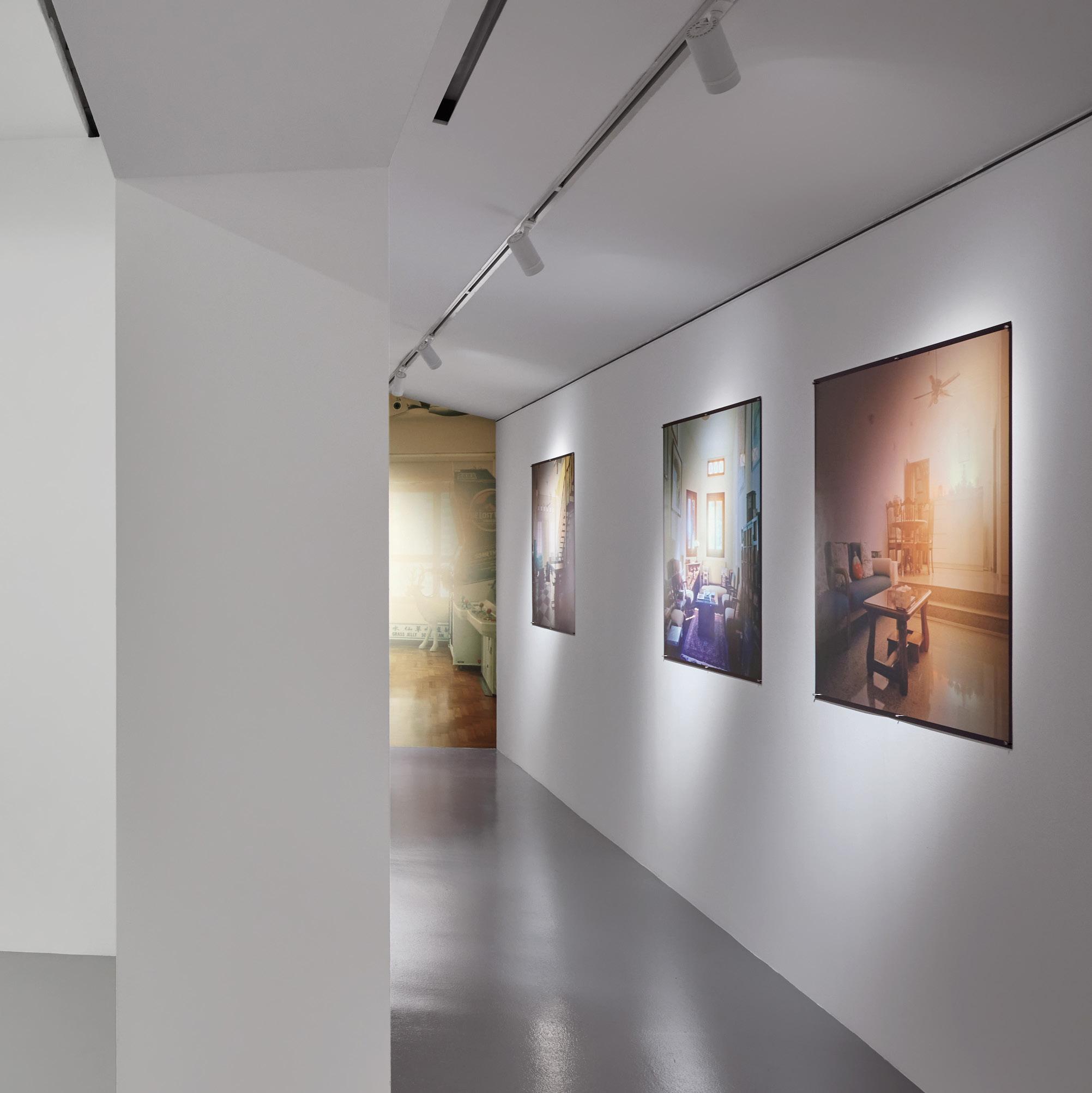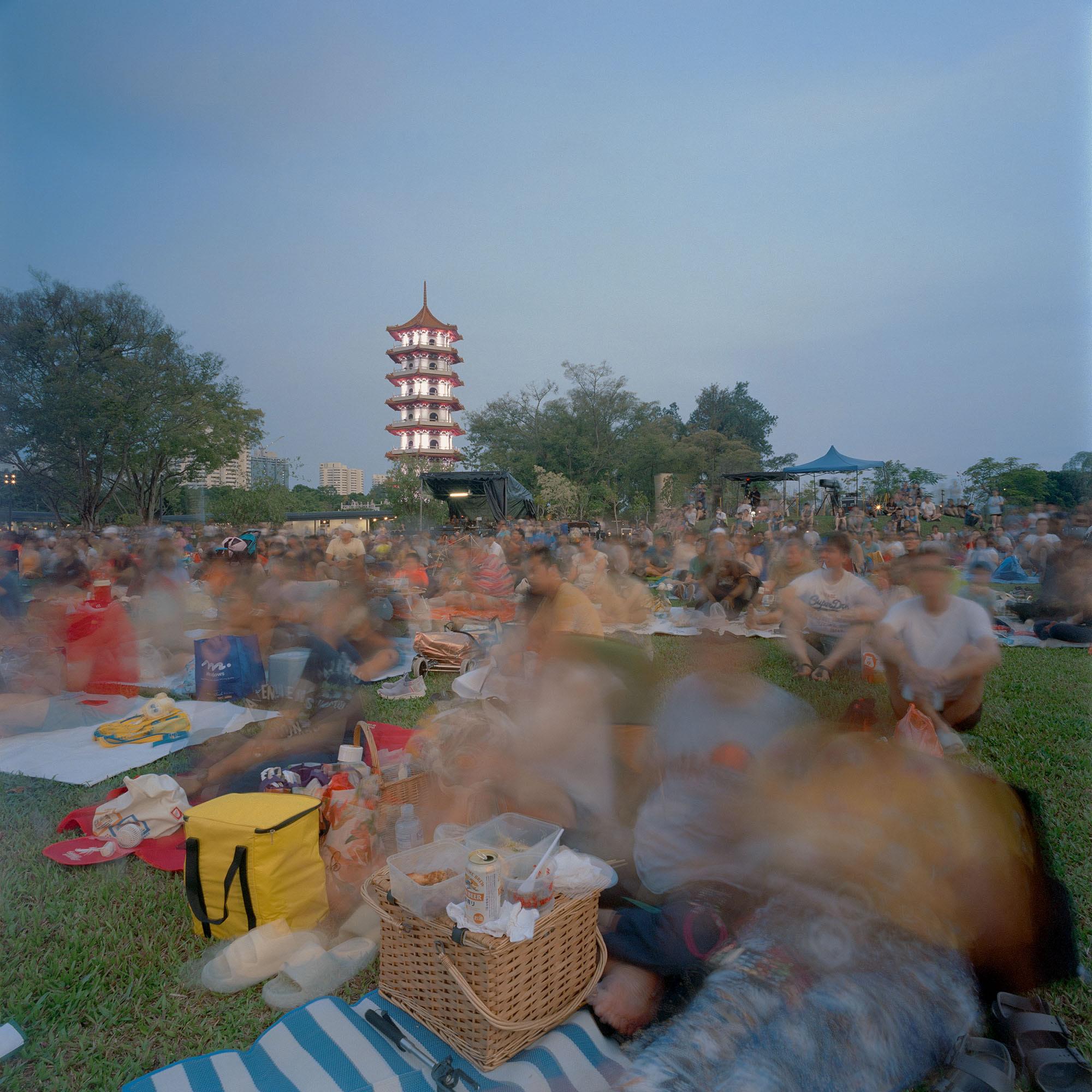

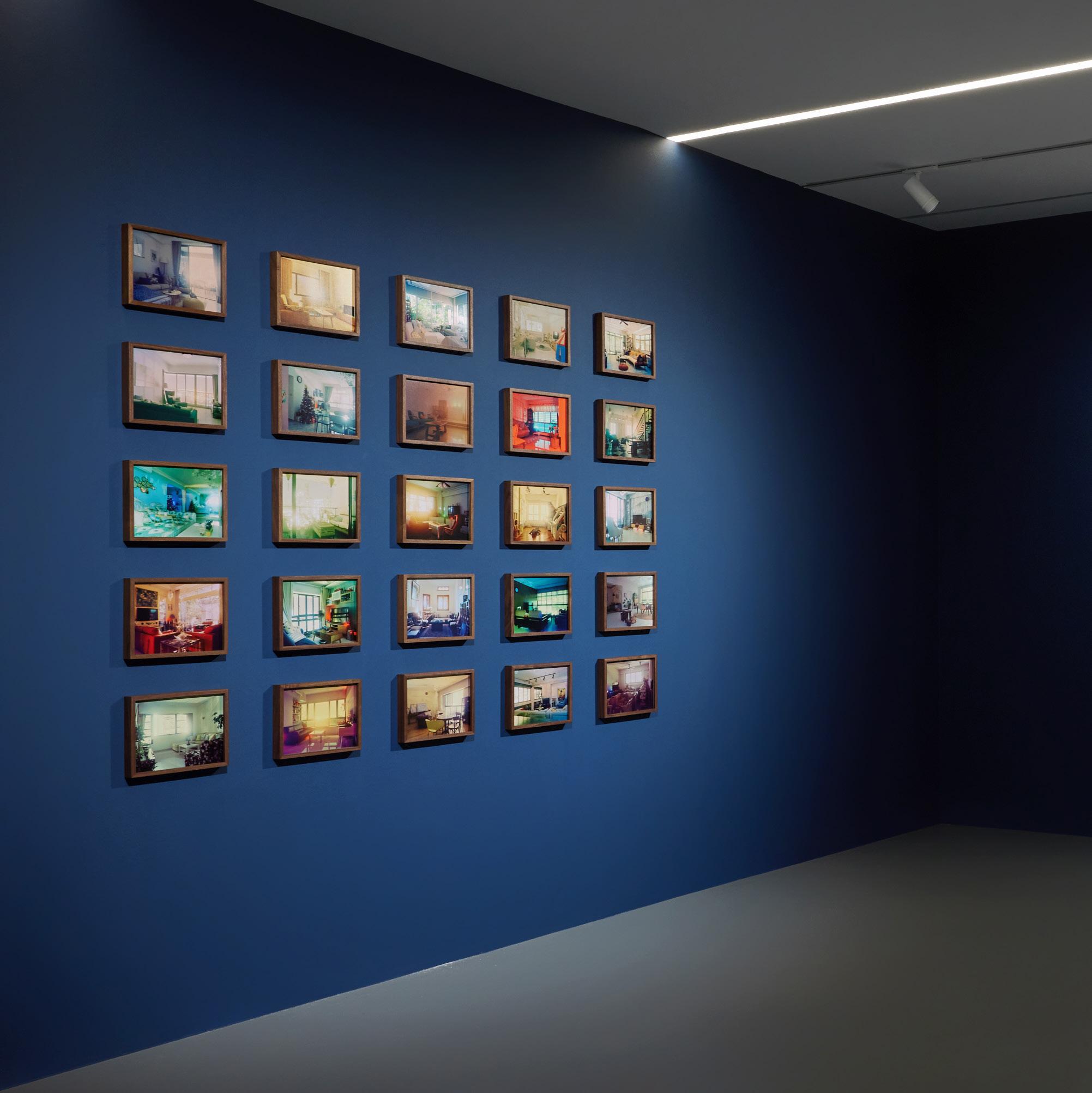
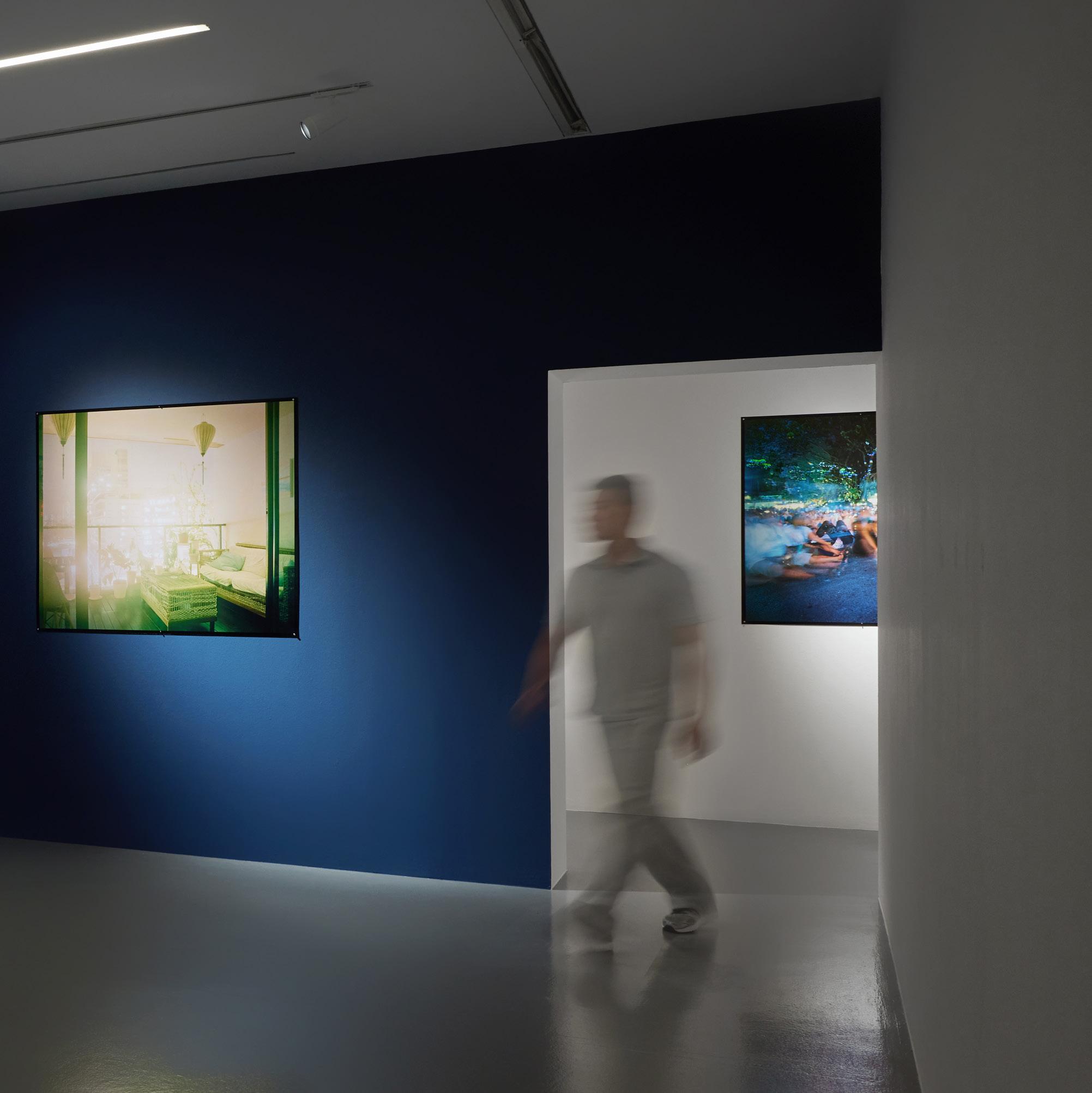





Lavender Chang
FOST Gallery, Singapore
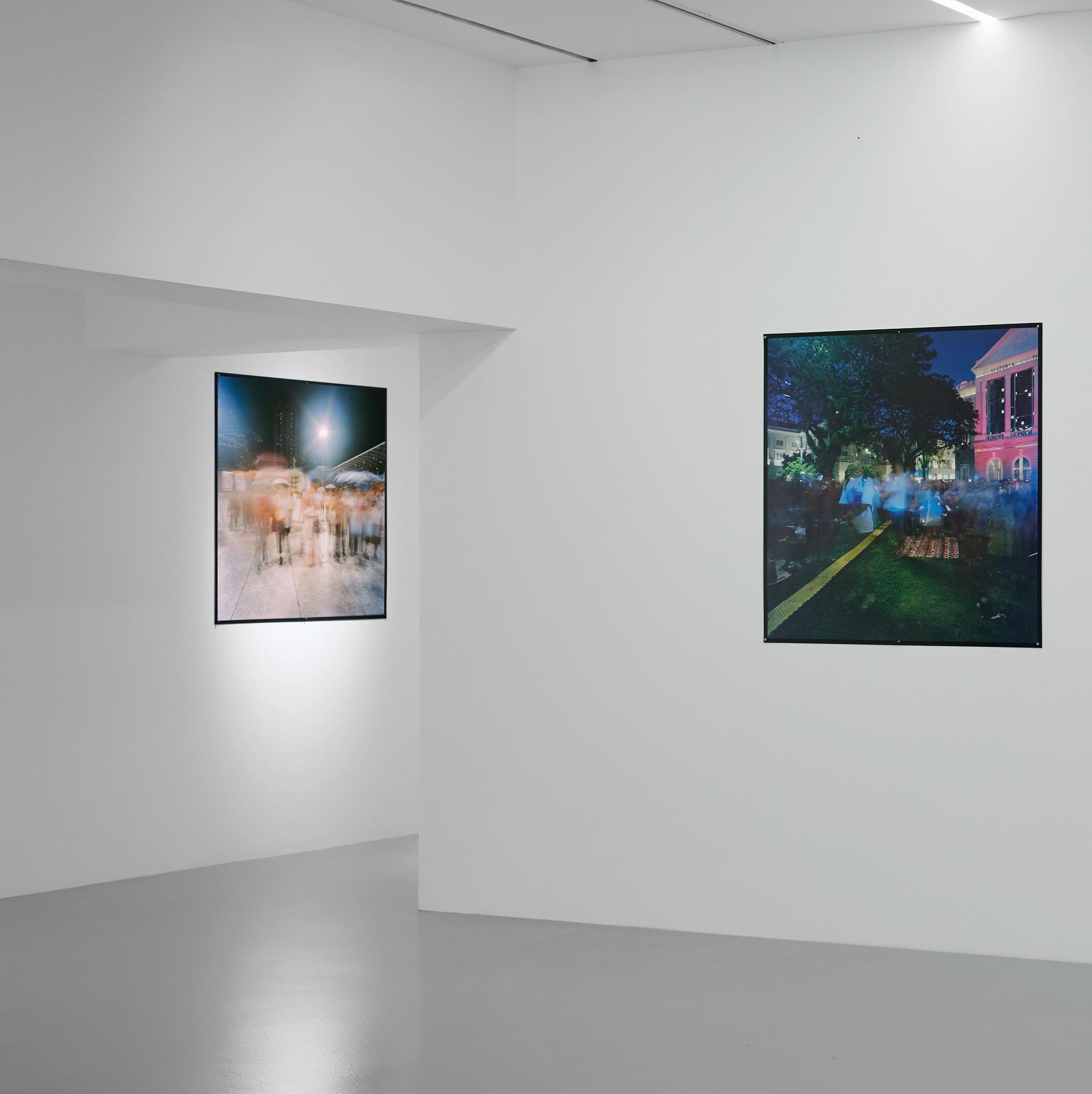
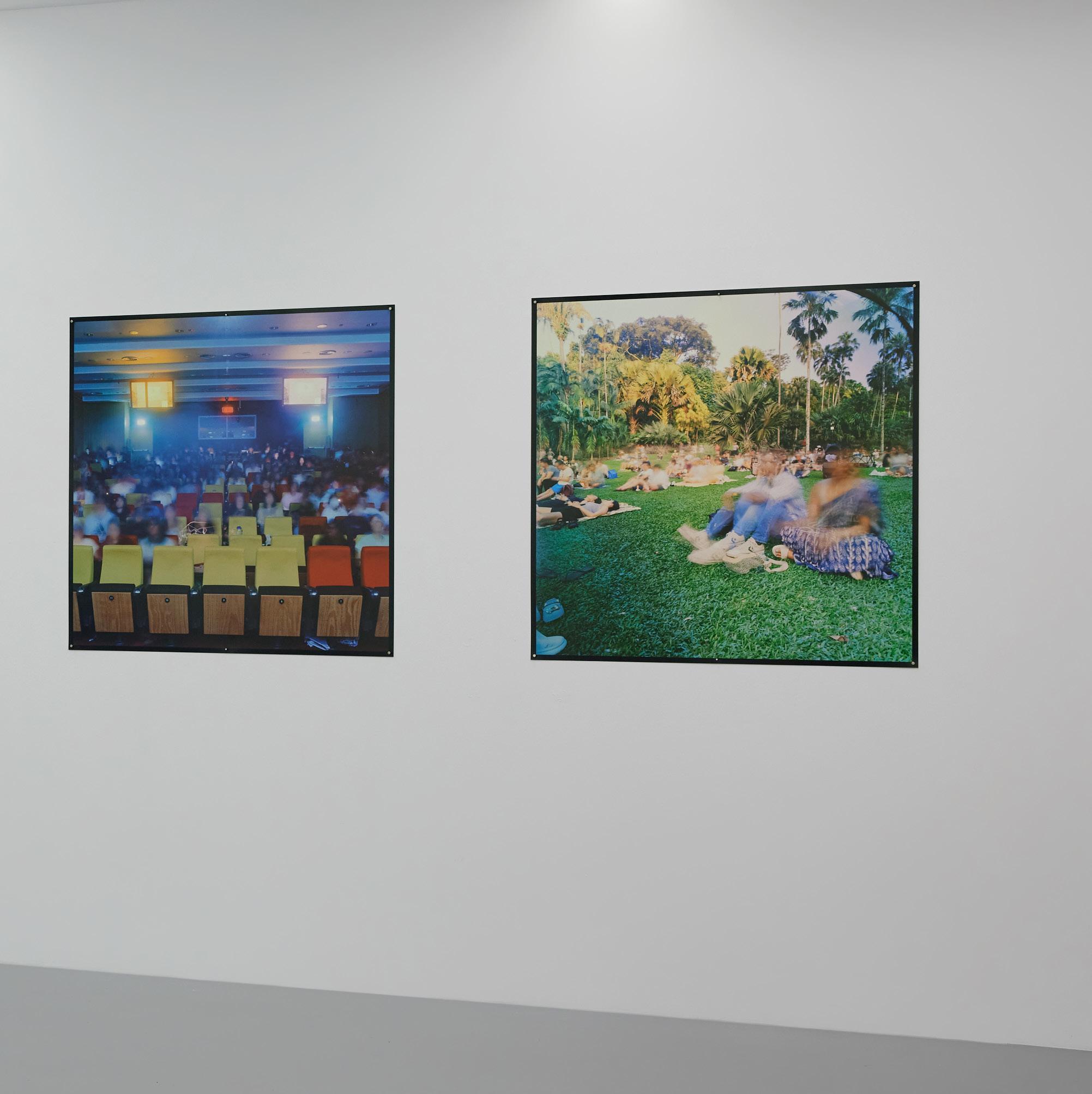
Essay by Dominic Low
The lift was jam packed. I was pushed left and right, People around me were sticky and sweaty Unwilling to give space. I had just a brief opportunity to snap that picture.1
— Alex (Cooling-Off Day by Alfian Sa’at, 2012)
The hot and claustrophobic circumstances described by Alex, a retired entrepreneur in Sa’at’s play who takes a viral photograph of a political rally during Singapore’s 2011 General Election, may provoke enochlophobia (the fear of crowds) in some. Yet they also serve as a perfect foil to Lavender Chang’s new series, The Temporary We (2024 –ongoing), of which the works in this exhibition at FOST Gallery have not been presented before. By exploring two of Chang’s most recent series, the other being Silent Knight (2018 – 2021), on view here in its entirety for the first time, this essay proposes to cast into greater relief the artist’s conceptual approach to photography and her continuous meditations on the themes of time, chance and personal relationships.
In contrast to Alex’s endeavour in Cooling-Off Day to capture the
3 1 1 Alfian Sa’at, Cooling-Off Day, (Singapore: Ethos Books, 2012), p.116.
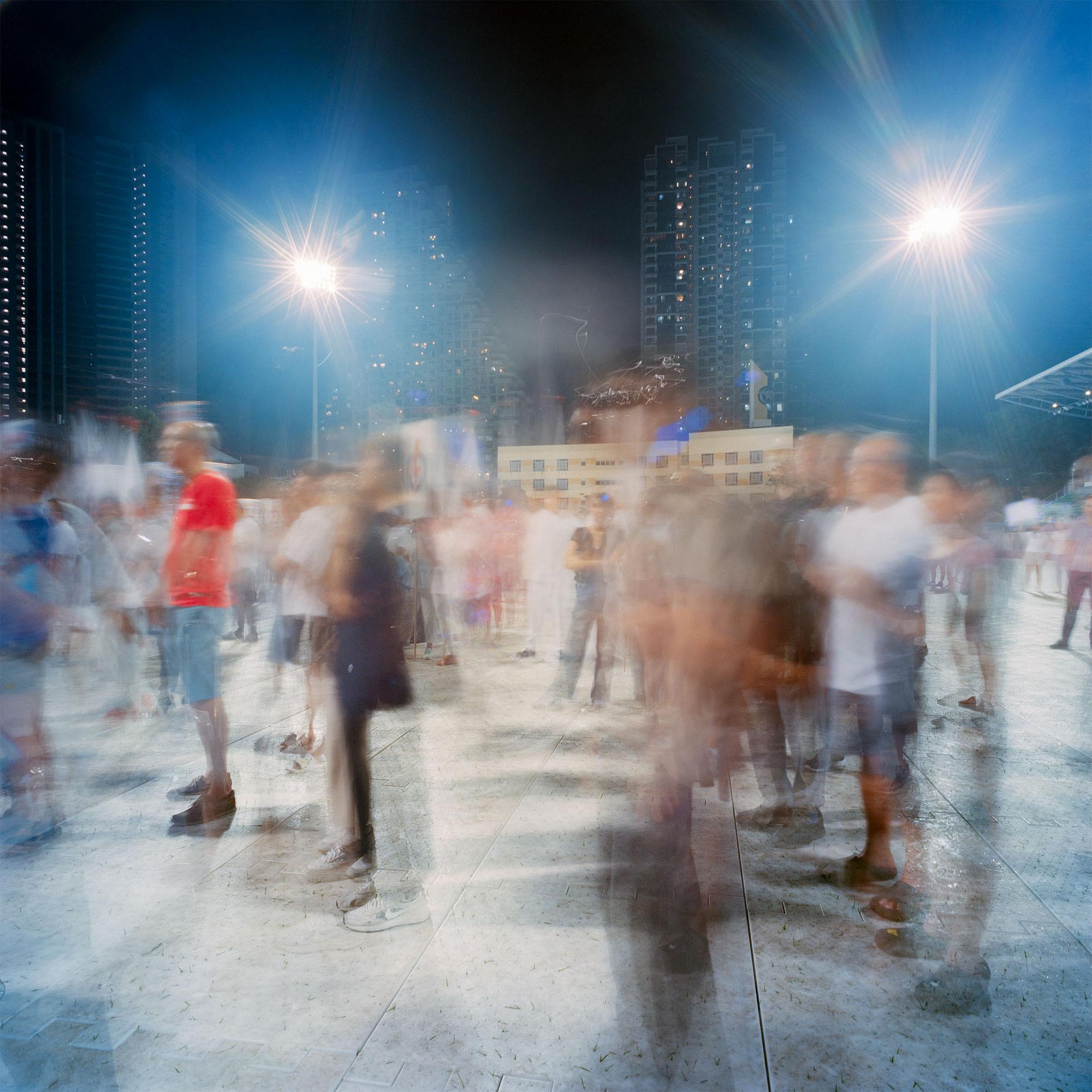
totality of the crowd from a distance on the thirteenth floor of a nearby building, Chang’s approach to the crowds in four of the works in this exhibition from The Temporary We — Tampines Ave 9, Singapore #1 (April 26, 2025), Bedok North Street 2, Singapore #3 (April 29, 2025), Bishan Street 14, Singapore #2 (April 30, 2025), and Bishan Street 14, Singapore #5 (April 30, 2025) — was to embrace them head-on, joining the ranks of the throngs of attendees herself. Where Alex’s fictive image fixes a singular moment in a snapshot that ends up defining the crowd at the rally and the election, Chang’s works allow for the vagaries of time and the emergence of alternative interpretations. The images in The Temporary We are not snapshots, but long exposures that last for the duration of an activity, which in the case of the aforementioned four works, are speeches at a rally. She thus denies the viewer a neat summary of the people present, instead suggesting individual differences beneath the appearance of collectivity. “The space between people is a medium in itself, shaped by perception and intention…I notice the closeness and the gaps, the tension between connection and separation. I cannot fully access the inner world of another, but I can feel its weight beside me,” the artist observed.
Just as impressions of individuals weave in and out of her images, never staying stationary long enough to be clearly recorded by the camera, Chang expresses the crowd as an unstable state of existence, which momentarily coalesces around a convergence of desires, needs and interests. For collectivity is neither monolithic nor permanent. It lasts for only as long as its members share a common purpose, be it to shop at thrift markets, to attend lectures, to partake in festive celebrations (Christmas, Mid-Autumn Festival, National Day) or to spend time at iconic landmarks in Singapore (Gardens by the Bay, Merlion Park, Singapore Botanic Gardens). Its contours are constantly shifting and its size fluctuating as some people arrive while others leave. Chang recounted with wistfulness the small moments of personal interaction she had had with individuals in the crowd, for she was acutely conscious of the fact that they might never cross paths again following the conclusion of the activity and the inevitable dispersal of the crowd.
Chang has always been interested in the social relationships that are
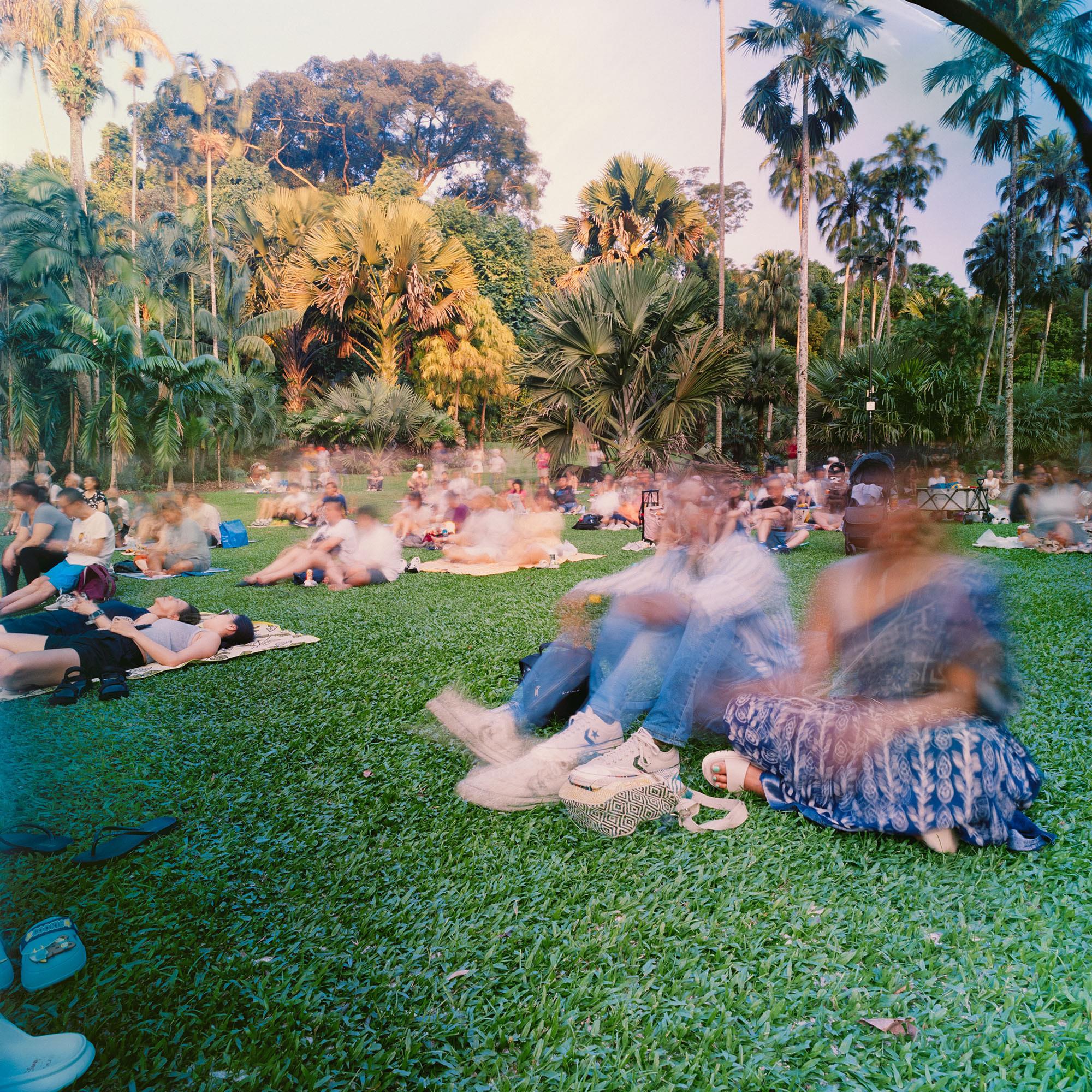
embedded within the photographic image. Ranging from Block 12, My Territory, My Dignity (2010-2011) to Don’t Walk In Front Of Me, I May Not Follow (2021), she pushes against the conceptual boundaries of photography, developing a social dimension in her creative process that underpins the formal qualities of her work. She developed the most elaborate set of rituals yet for Silent Knight, a series of 25 works, as well as for its sister series Sheltered Dreams (2023), which was commissioned by the Peranakan Museum and acquired for Singapore’s National Collection.
Every process Chang undergoes to create each of the works in Silent Knight and Sheltered Dreams first begins with a visit in person to the houses depicted in her photographic works. The relationships that grew out of interactions with the residents are still treasured by the artist, for she is deeply aware they had invited her into their private lives and permitted her a rare glimpse at the everyday routines which shaped and reshaped these domestic spaces. In addition, it is part of her ritual to commune with participants, often over a meal together, before deciding on the angle for the camera. Only when the residents retire to their bedrooms for the night, leaving the living rooms in darkness, does Chang finally begin to make the image using her long-exposure technique. It is a lengthy process that takes hours on end, concluding only when the residents awake. During this time, which averages around eight hours, she keeps vigil, keenly monitoring the entire process. Chang recalled, “I am alone in the darkness, listening to the silence. I give in to the calmness around me, as I watch the play of light and shadows. I am but a bystander in their lives for this one night. I feel sad that I may never be here again. I want to make the most of this moment, to take it all in.”
Neither are the results of the night’s efforts ever certain, especially given that the process permits the creation of only one singular image at any one time. Although Chang frames the composition and determines the conditions around which the work is created, numerous elements of the image remain beyond her control. The play of colours, light and shadows, for instance, can only become apparent after the film is developed. And even then, she remains open to the intervention of chance, refusing to edit out unintended effects during the postproduction process. Her methodology stands out in today’s image

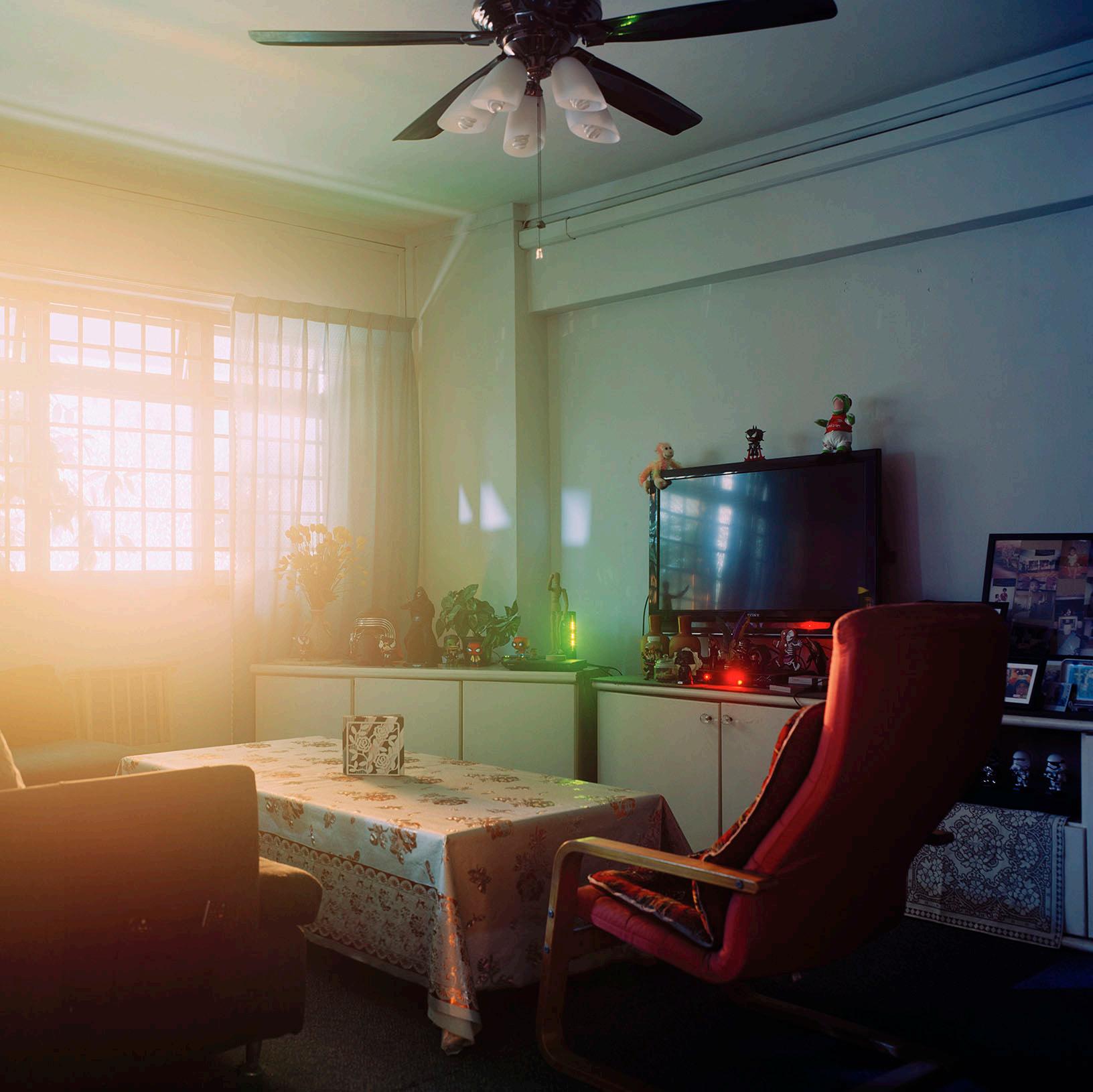
economy where, as curator and art historian Charmaine Toh describes “with the mobile phone camera, the internet and social media, photography has become the dominant visual medium of this generation and has shaped ever more profoundly the ways we see and engage with the world. Photography has become a way of seeing, thinking and interacting, rather than just one medium among many.”2 The speed at which images can now be produced—the snapshot and AI-generated images being prime examples — runs counter to Chang’s celebration of social interaction, her time-consuming process of long-exposure photography, and embrace of chance and uncertainty in image-making.
In his essay about the development of conceptual art in Southeast Asia, art historian and critic T.K. Sabapathy notes that “Conceptualism is esteemed as reaching out even further, nudging art into assuming connections with other constituencies or realities that are embraced as forming milieus in which artists pursue their practice, such as the social, the political and the economical.”
3 The social not only constitutes an important aspect in Chang’s creative process, and in the production of meaning and interpretation of her work, it also often figures as subject matter. Each work in the Silent Knight series is in fact a portrait, where sitters, despite not being physically visible in the photograph, make their presence felt through the everyday spaces they inhabit. The material traces they leave behind hint at their different personalities, interests and routines. In Silent Knight #03-573 (2018) for example, the playpen that occupies the foreground and the array of toys distributed around the room suggest at once the joys and challenges of raising young children, while in Silent Knight #150 (2019), the volumes of books and framed prints set against a luminous backdrop of light streaming through the windows from the street outside point to a passion for art. Chang never fails to emphasise to participants the importance of leaving the spaces untouched, without cleaning or posing for the camera. The authenticity
2 Charmaine Toh, “Living Photographs,” in Living Pictures: Photography in Southeast Asia, ed. Charmaine Toh (Singapore: National Gallery Singapore, 2022), p.12.
3 T.K. Sabapathy, “Reading Conceptual Art in Southeast Asia: A Beginning,” in Charting Thoughts, ed. Low Sze Wee, Patrick D. Flores (Singapore: National Gallery Singapore, 2017), p.234.

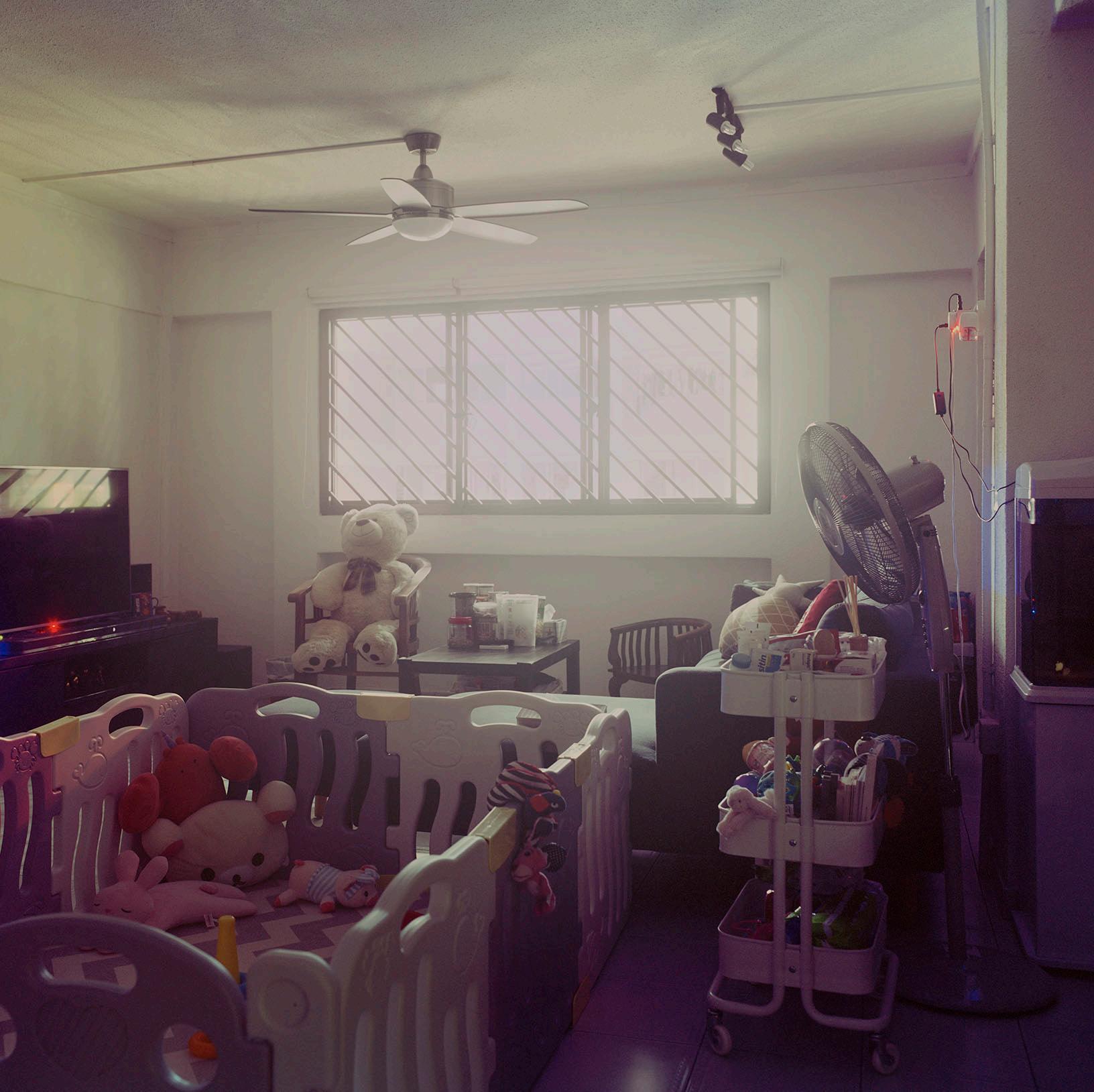
of lived experiences, or what the artist calls “the essence of the human presence” is key to her desire to shine a spotlight on the significance of the mundane and the familiar which we often forget or take for granted amidst the hustle and bustle of daily life.
The living room is a recurring subject in Chang’s Silent Knight. In Singapore, as in many other countries around the world in the 21st century, the living room functions as the site for the making of shared memories, the gathering of family and friends, and the celebration of annual festivities and life events. It has, perhaps more than any other space within the house, become a synecdoche for the house itself. French philosopher Gaston Bachelard in The Poetics of Space (1994) accounts for the universal resonance of the home in terms of inhabitation, which is deeply rooted because “the house we were born in has engraved within us the hierarchy of the various functions of inhabiting. We are the diagram of the functions of inhabiting that particular house, and all the other houses are but variations on a fundamental theme.”4 Chang’s images thus echo our own individual experiences of inhabitation and yet appear dissimilar at the same time. In fact, the images provoke more questions than provide answers, keeping the identity of each home and its secrets at an arm’s length from all onlookers, except its inhabitants. Therein this gap between knowing and unknowing lies the artist’s invitation to imagination and reflection. She asserted, “I am always interested in how viewers draw from their own experiences and interpret my works because they complete the image.”
This exhibition at FOST Gallery, Where We Have Left Ourselves, juxtaposes Chang’s two most recent series, and places them alongside one another in a dialogue that allows for a clearer understanding of her interest in spaces through the dialectic of interior and exterior, private and public, home and city. With the abstraction of figures in The Temporary We and the substitution of presence in Silent Knight, the architectural backdrops come to the fore in a manner of speaking. The cityscape of Singapore in The Temporary We varies from HDB apartments in the heartlands to popular tourist destinations, while
4 Gaston Bachelard, The Poetics of Space (Boston, Massachusetts: Beacon Press, 1994), p.13.

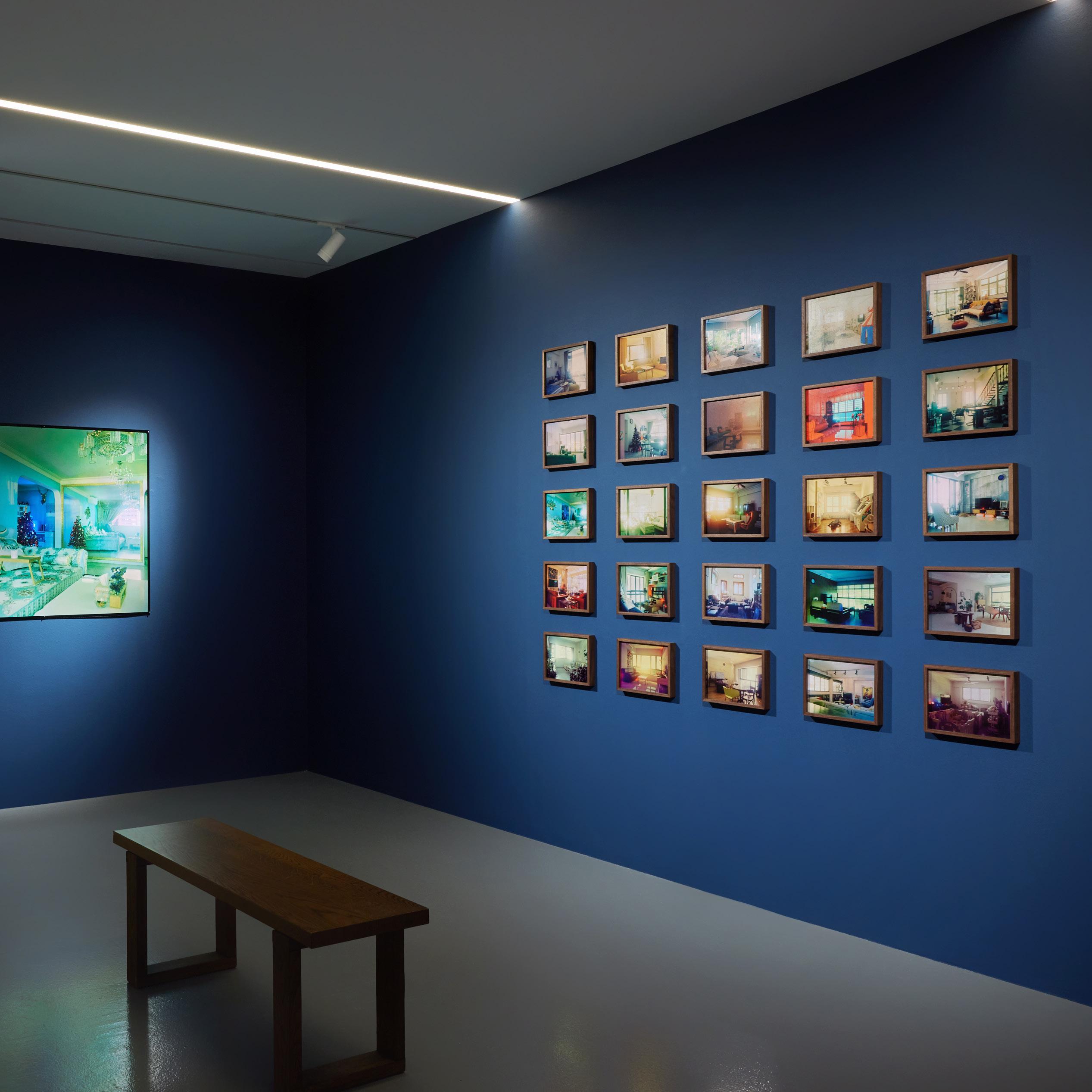
the mix of participants whose domestic spaces are depicted in Silent Knight are in fact multicultural, multinational, and represent all walks of life. The artist shared that although it was never her intention to define and exemplify the cultural melting pot that is Singapore, the result in hindsight was nonetheless a natural, and somewhat unsurprising, consequence of living in a society where multiculturalism could be intimately experienced in many ways every day. Just as Bachelard writes that “a reminder of winter strengthens the happiness of inhabiting,” the chilling effects of the global political climate today make clear the pertinence of the two series. In both The Temporary We and Silent Knight, the transformation of spaces of inhabitation by way of Chang’s distinctive conceptual approach prompts a deeper reflection on home, belonging, and the humanity that connects us all.5
Dominic Low is an independent curator and art historian. His research focuses on interiors, textiles and art historical hierarchies. Among the exhibitions he has curated are the Family and Community Life, Batik and Decorative Textiles permanent galleries of the Peranakan Museum (2023), #SGFASHIONNOW (2022 and 2023), Joseon Korea: Court Treasures and City Life (2017) and Eng Tow’s Grains of Thought (2015).
5 Gaston Bachelard, The Poetics of Space (Boston, Massachusetts: Beacon Press, 1994), p.40.

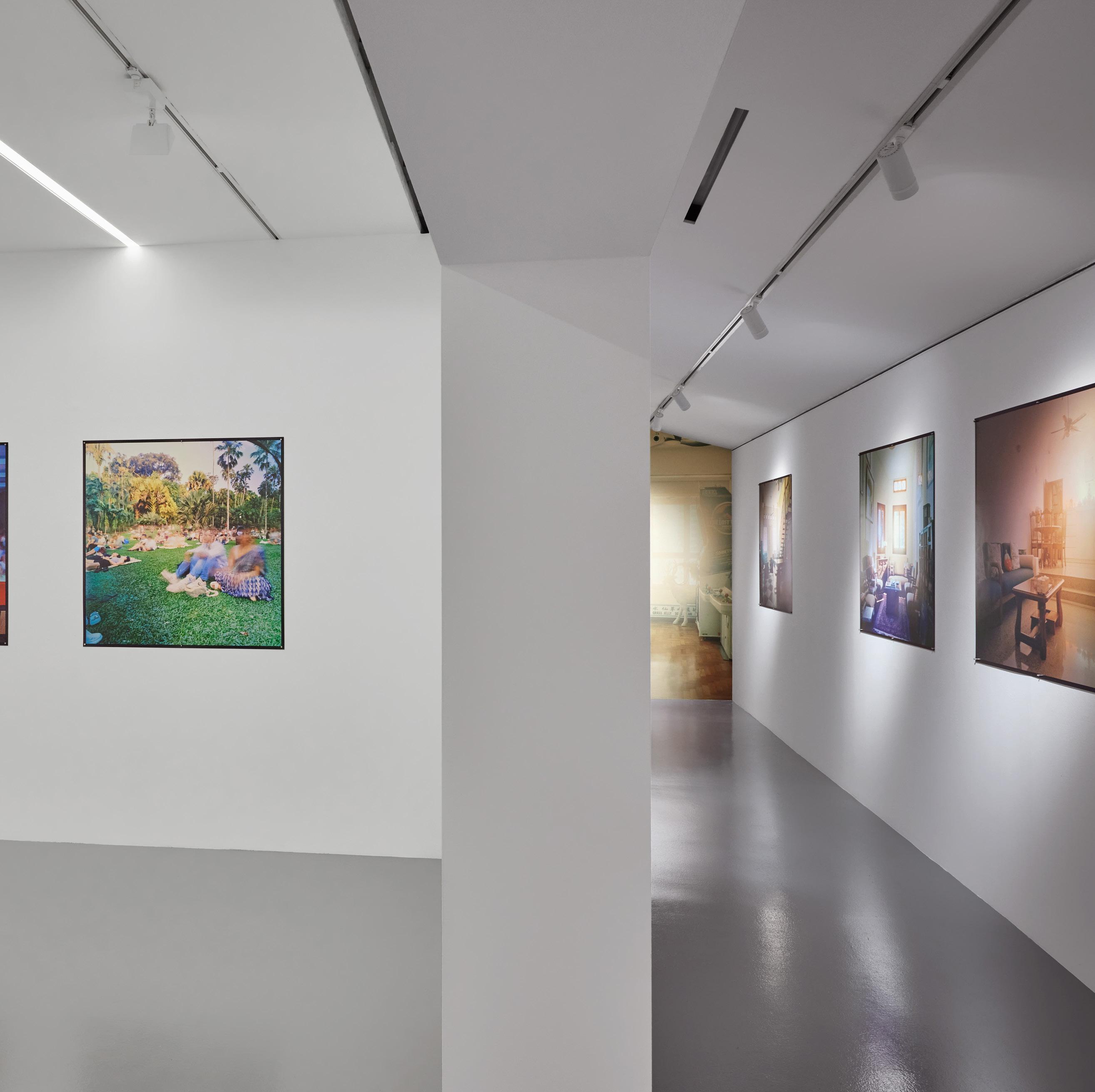
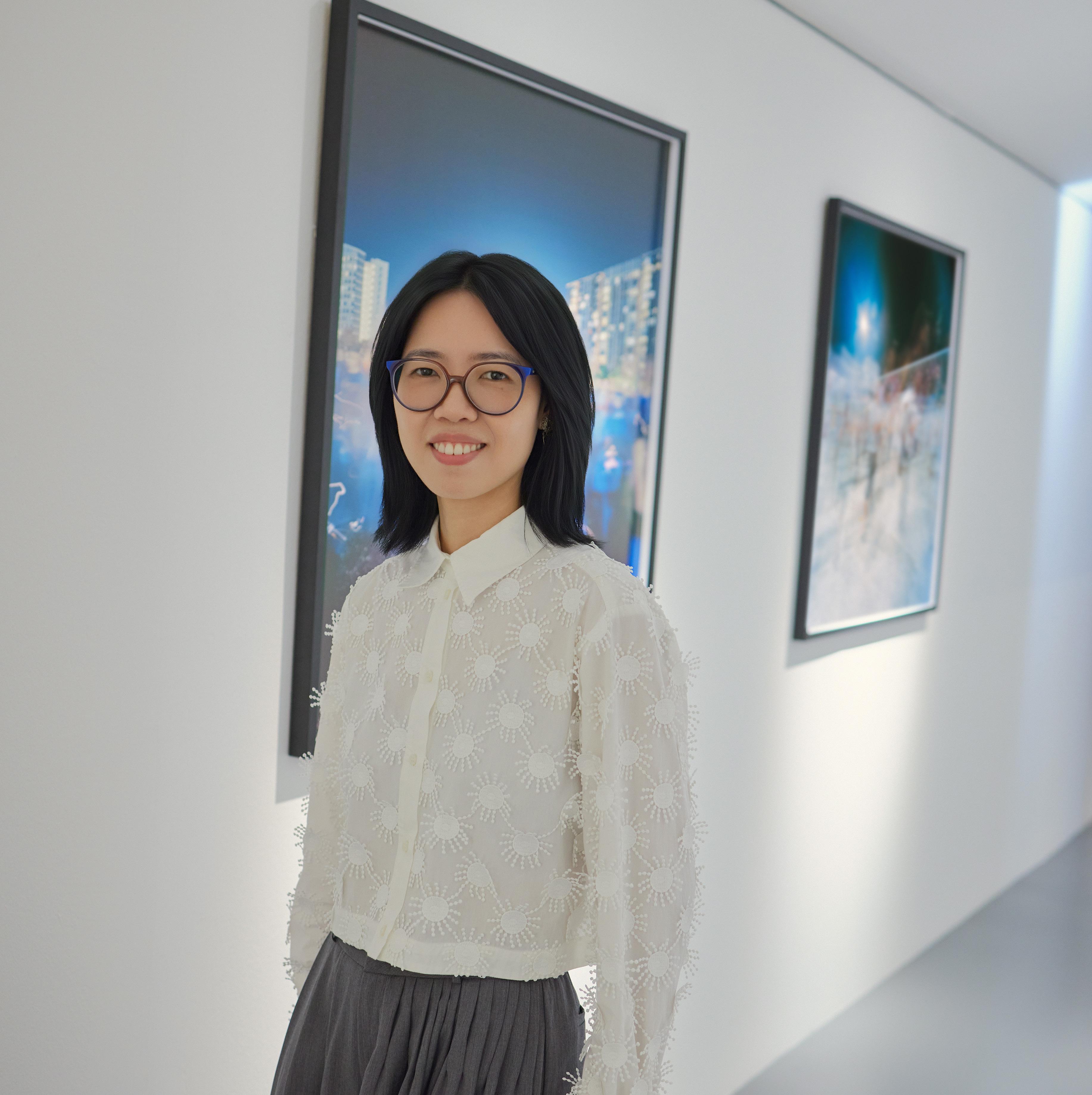
Lavender Chang is known for her conceptual photographs. Her processbased practice reflects her acute observations of the subtle nuances in daily life and exploration of the imperceptibility and transience of time, memory, and mortality.
Chang’s extensive exhibition history includes solo exhibitions: Where We Have Left Ourselves, FOST Gallery, Singapore (2025); A Glimpse of Radiance from Under, FOST Gallery, Singapore (2022); Diverse Oneness, commissioned by Alliance Française de Singapour for its 70th anniversary (2019); Floating Rays of a Wanderer, Art Porters Gallery, Singapore (2019); I Am a Seed Though A Different One From You, The Arts House, Singapore (2017); and The Movingly Minute Scale of a Restricted Life, Societe Generale, Alliance Française de Singapour, Singapore (2016).
The series, Sheltered Dreams, was specially commissioned by the Peranakan Museum for their Museum reopening exhibition in 2023. Selected group shows include Towards Happiness, Prosperity & Progress: Reflections on the Singapore Spirit, The Private Museum, Singapore (2025); Artist’s Proof: Singapore at 60, The Culture Story, Singapore (2025); Singapore; Elemental: Highlights from ADM Photography Alumni, ADM Gallery, Nanyang Technological University, Singapore (2025); Bandung Photography Triennale, Indonesia (2022); Ecopsychology, Objectifs – Centre for Photography and Film, Singapore (2019); In Praise of Shadows, ADM Gallery, (2017); Sensorium 360°, Singapore Art Museum, Singapore (2014); Kuala Lumpur International Photo Awards, Malaysia (2011); and International Orange Photo Festival, Changsha, China (2010).
She was the recipient of the Gold award at The Crowbar Awards, Singapore (2011); and the winner of the Noise Singapore Prize. In 2015, she won the 6th France+ Singapore Photographic Art Awards; one year later, her collaboration with &Larry won the President Design Award’s Design of the Year.
In recent years, Chang has been deeply involved in film-making. Her cinematography work for John Clang’s debut feature film, Their Remaining Journey, premiered at the 2018 International Film Festival Rotterdam and garnered a nomination for the festival’s Bright Future Award. It is also the opening film for the National Gallery Singapore’s Painting with Light: Festival of International Films on Art. In 2020, A Love Unknown was selected by the International Film Festival Rotterdam for its Bright Future Main Programme, and by the 12th DMZ International Documentary Film Festival for its Asian premier. The film went on to be selected for Singular Screens by Singapore International Festival of Arts, curated by Asian Film Archive (2021). Her debut feature film, Absent Smile, had its world premiere at the 2022 Singapore International Film Festival’s Singapore Panorama section and the Reciprocal 2023: Asian Film Archive x Eye Filmmuseum.
She was invited to speak about her practice at the TEDxNTU: Pause to Progress, Singapore (2022); and at TEDxMacauUST: Pureness Leads to Insight, Macau, China (2024).

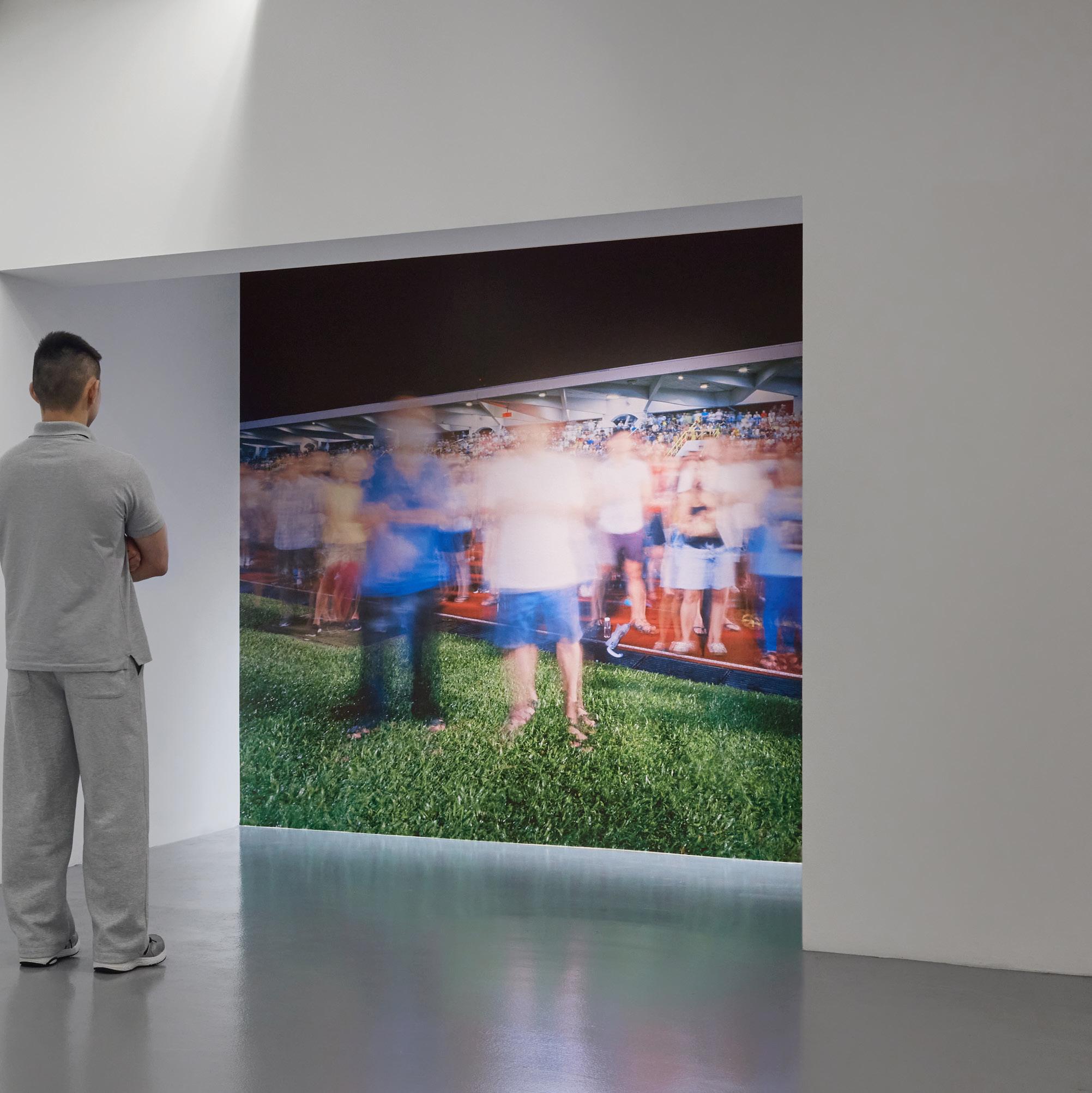
Bedok North Street 2, Singapore #3 (April 29, 2025)
2025
Fine art archival print
Edition of 3 + 2 Artist’s Proofs H100 x W100 cm (image)
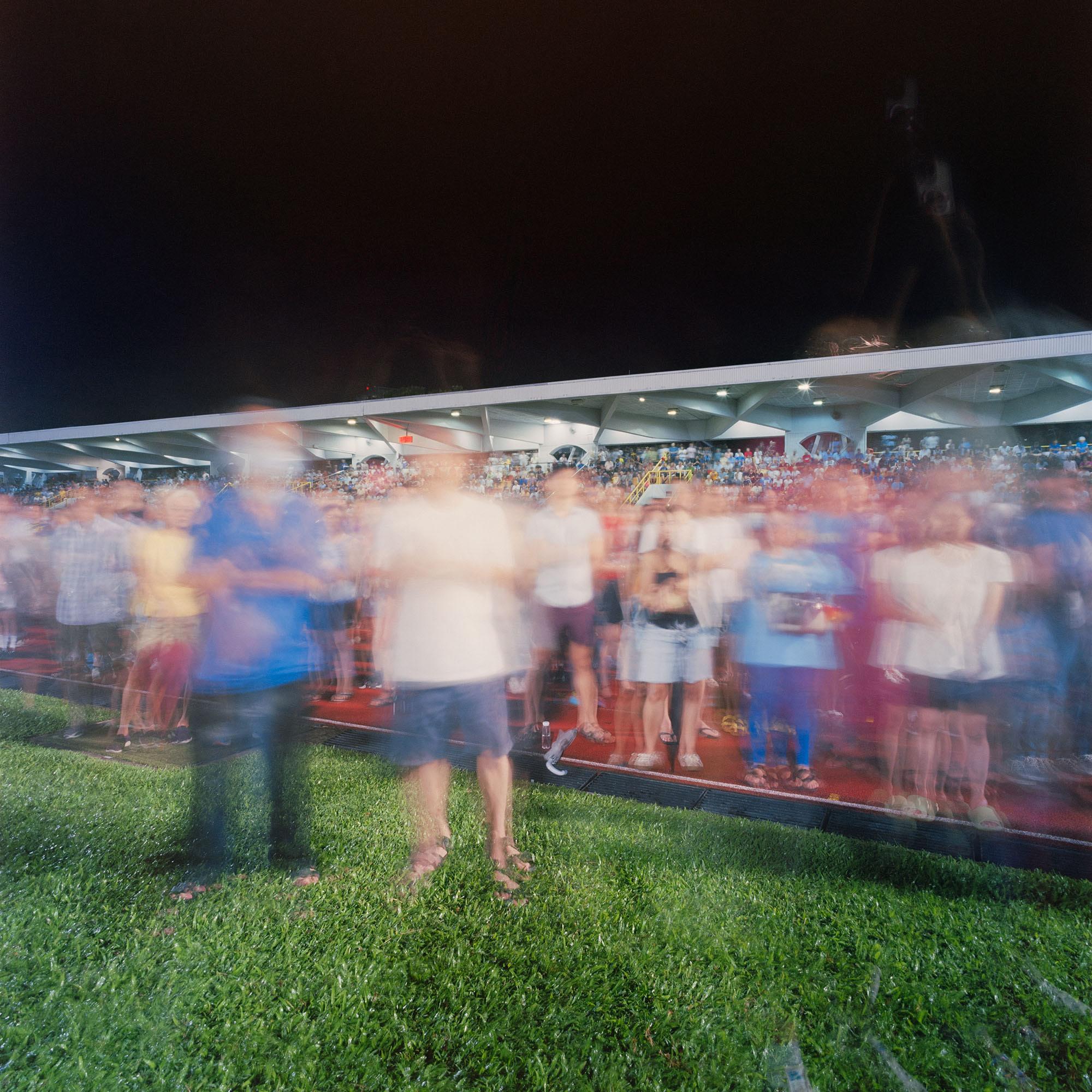
Bishan Street 14, Singapore #5 (April 30, 2025)
2025
Fine art archival print
Edition of 3 + 2 Artist’s Proofs H100 x W100 cm (image)

Tampines Ave 9, Singapore #1 (April 26, 2025)
2025
Fine art archival print
Edition of 3 + 2 Artist’s Proofs H100 x W100 cm (image)
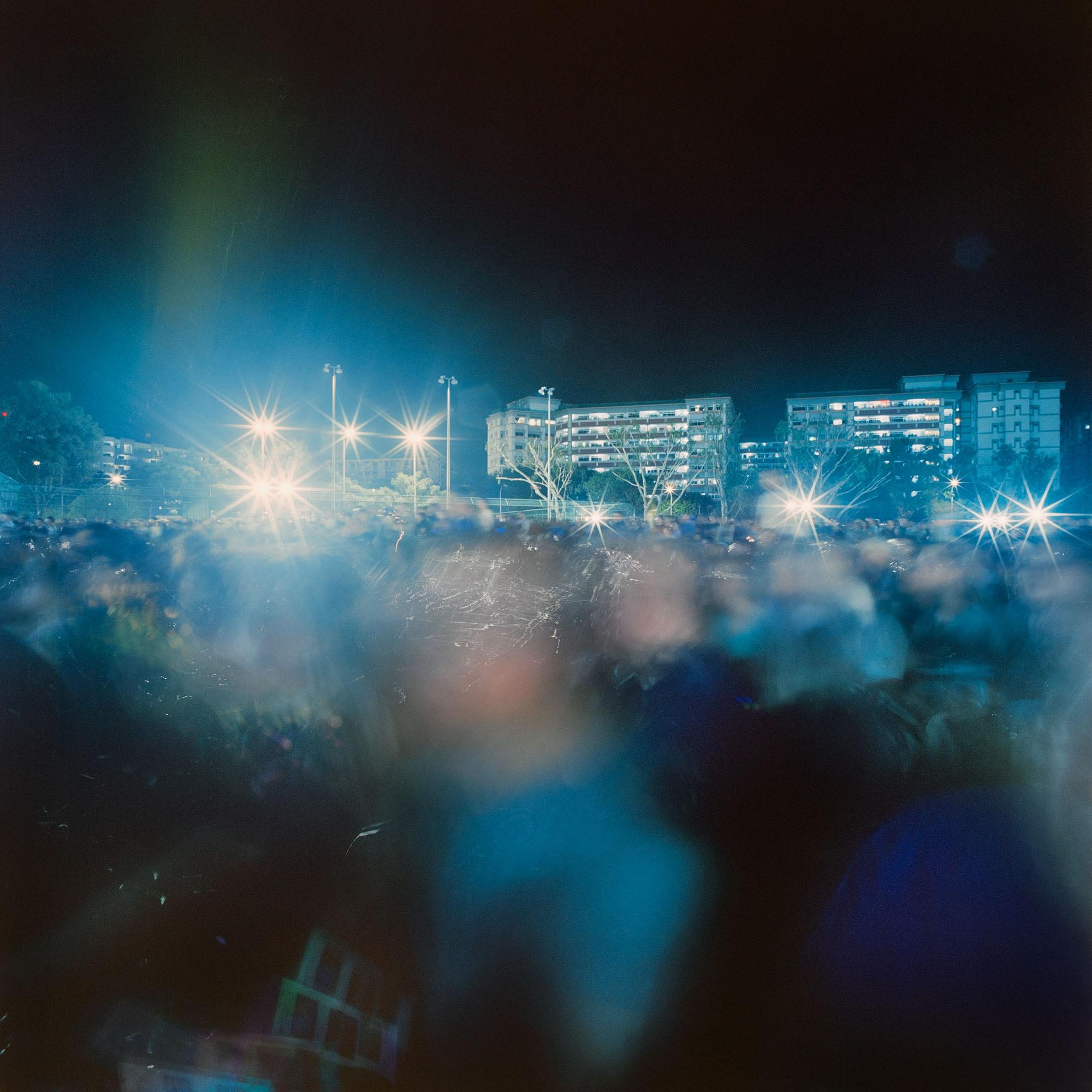
Yuan Ching Road, Singapore #1 (October 11, 2025)
2025
Fine art archival print
Edition of 3 + 2 Artist’s Proofs H100 x W100 cm (image)

Cluny Road, Singapore #2 (July 5, 2025)
2025
Fine art archival print
Edition of 3 + 2 Artist’s Proofs H100 x W100 cm (image)

Medical Drive, Singapore #1 (November 18, 2024)
2024
Fine art archival print
Edition of 3 + 2 Artist’s Proofs
H100 x W100 cm (image)
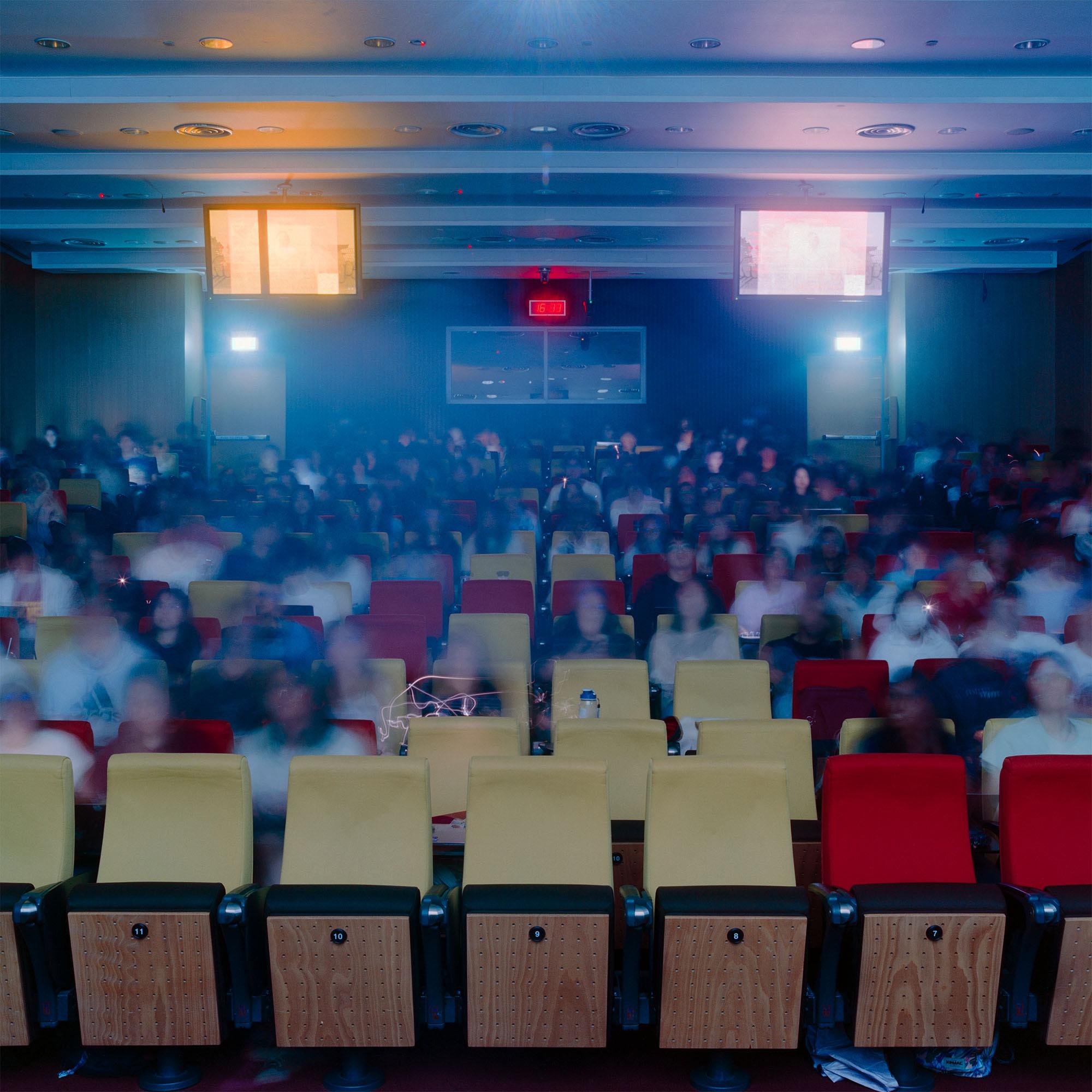
Empress Place, Singapore #3 (August 9, 2025)
2025
Fine art archival print
Edition of 3 + 2 Artist’s Proofs
H100 x W100 cm (image)
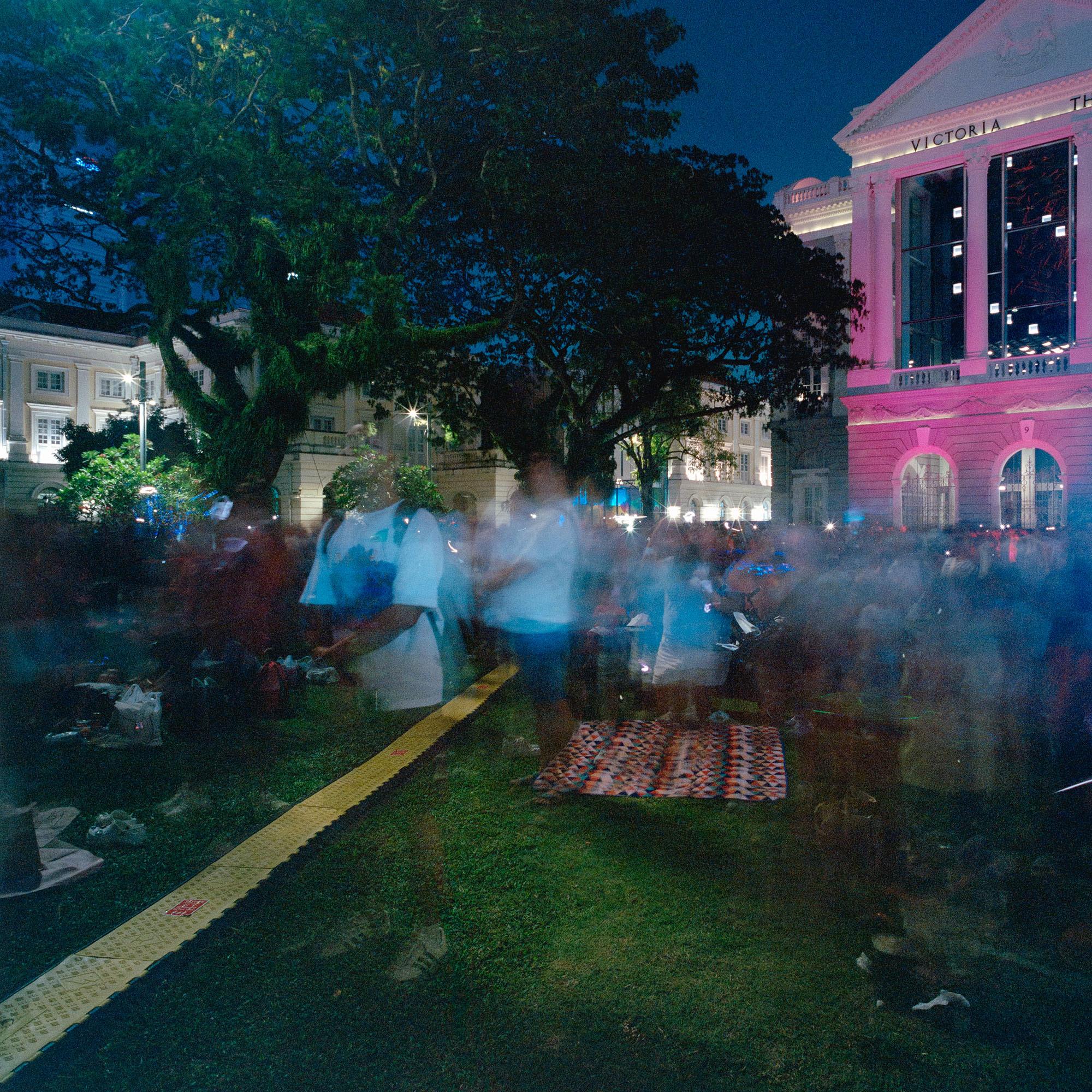
Fullerton Road, Singapore #1 (August 24, 2025)
2025
Fine art archival print
Edition of 3 + 2 Artist’s Proofs
H100 x W100 cm (image)
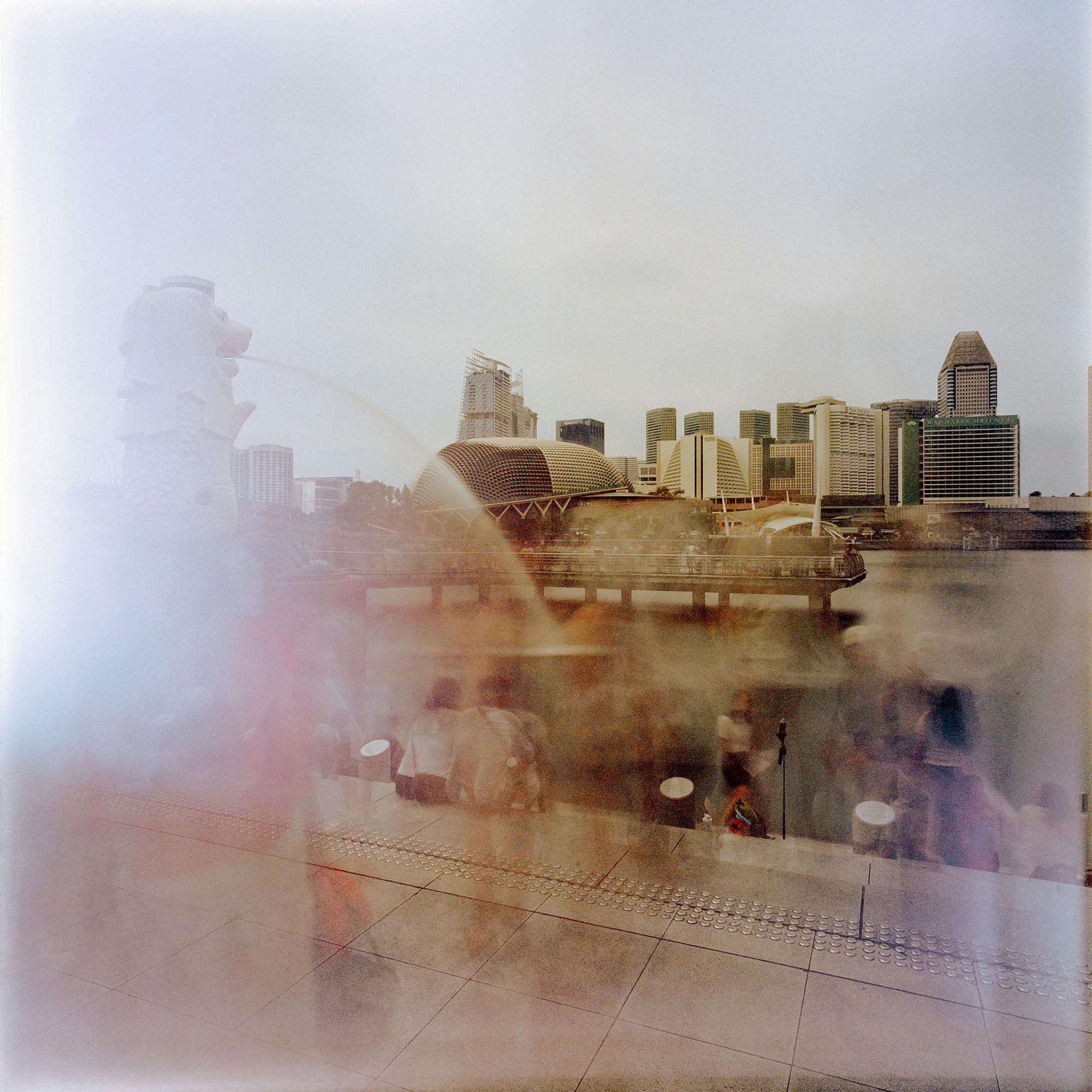
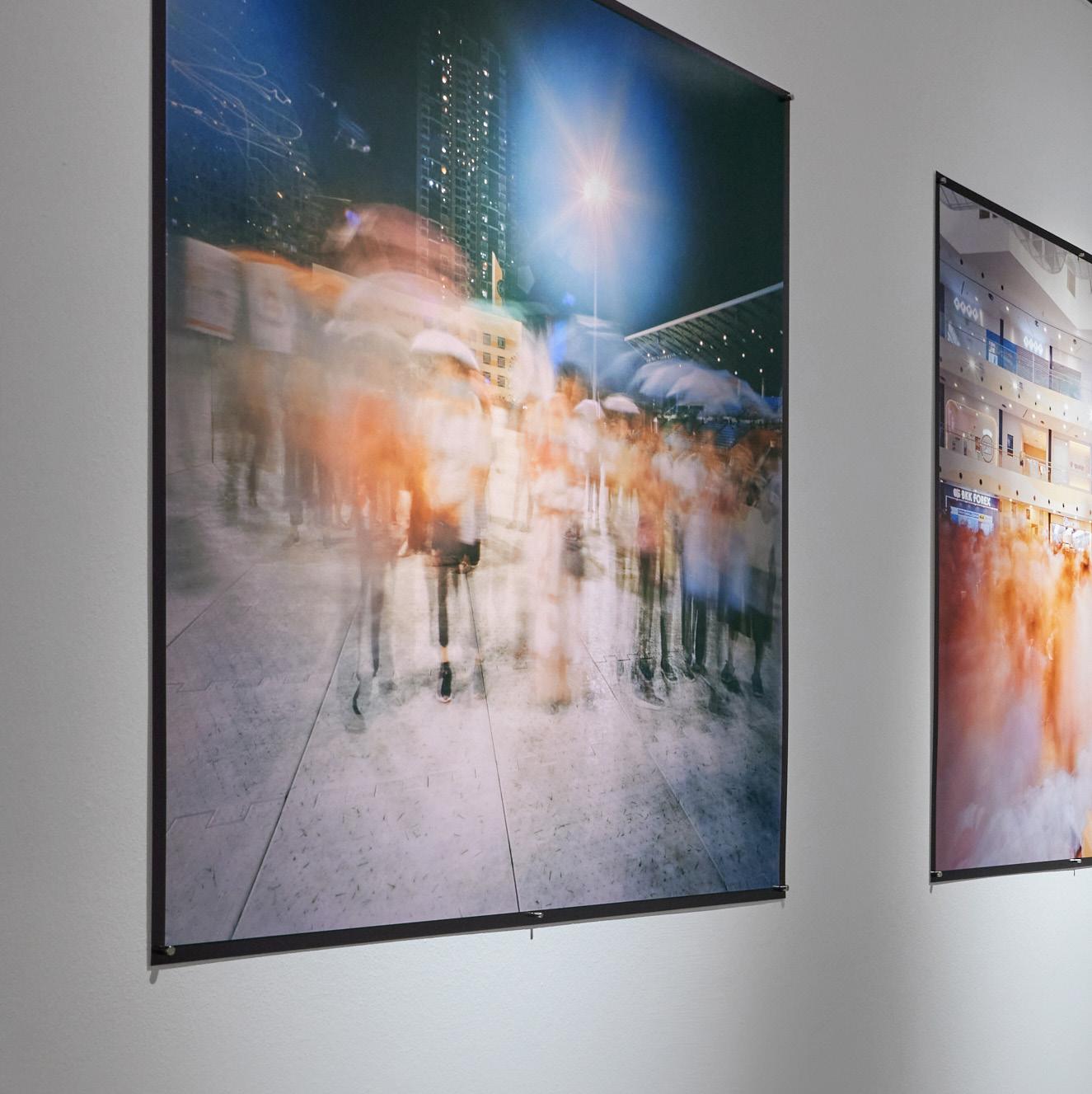
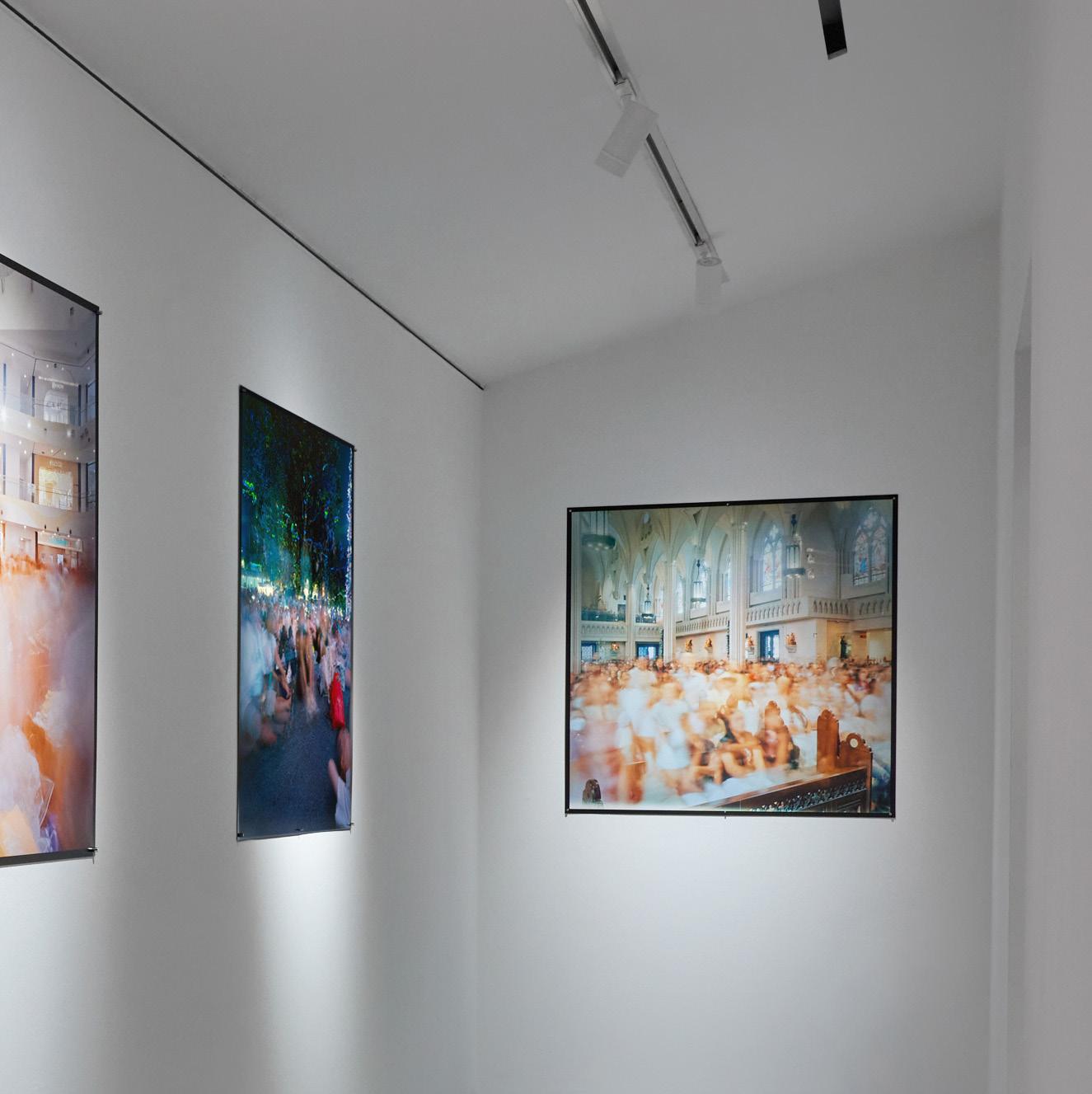
Bishan Street 14, Singapore #2 (April 30, 2025)
2025
Fine art archival print
Edition of 3 + 2 Artist’s Proofs H100 x W100 cm (image)
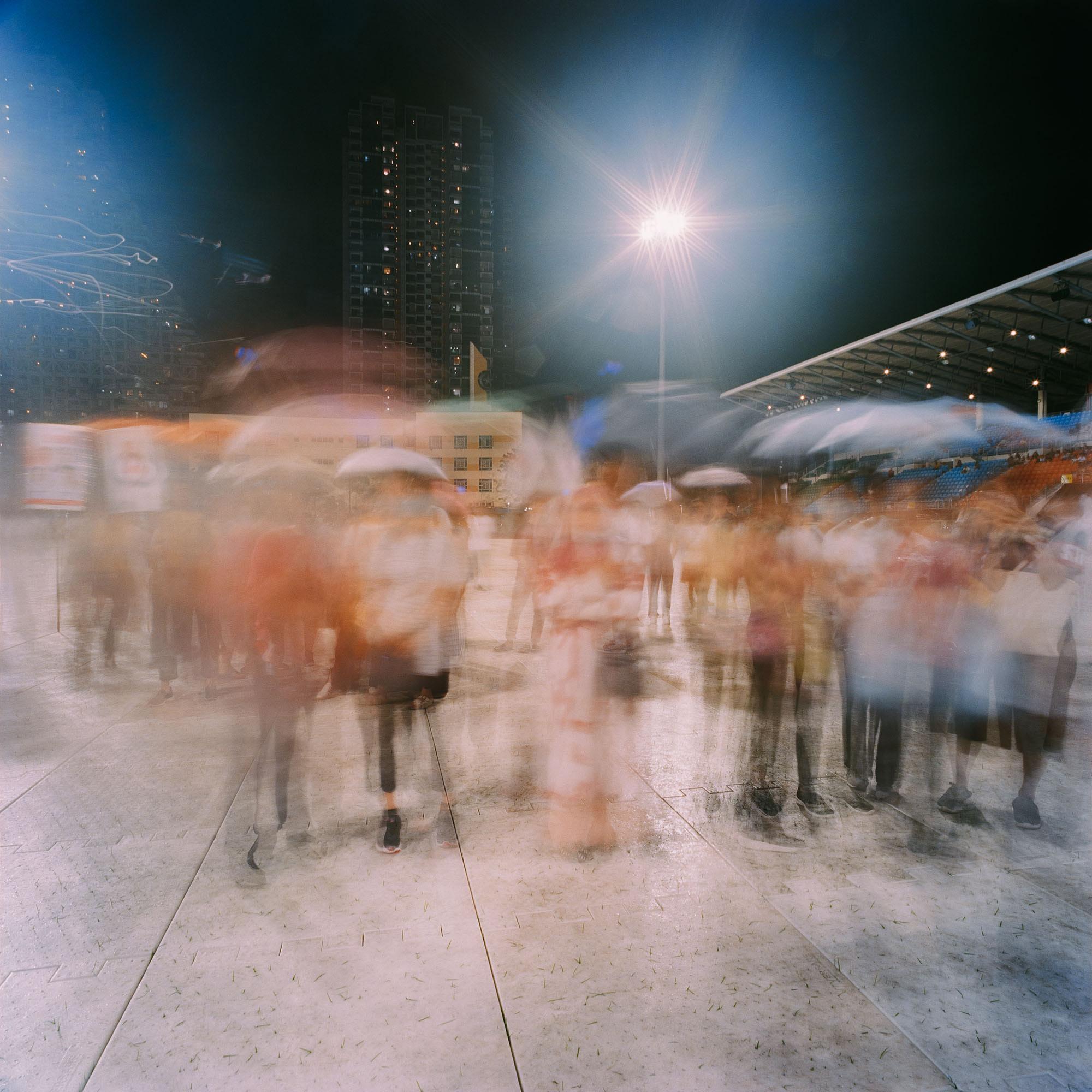
Kallang Ave, Singapore #1 (August 31, 2025)
2025
Fine art archival print
Edition of 3 + 2 Artist’s Proofs H100 x W100 cm (image)

Marina Gardens Drive, Singapore #2 (July 5, 2025)
2025
Fine art archival print
Edition of 3 + 2 Artist’s Proofs H100 x W100 cm (image)
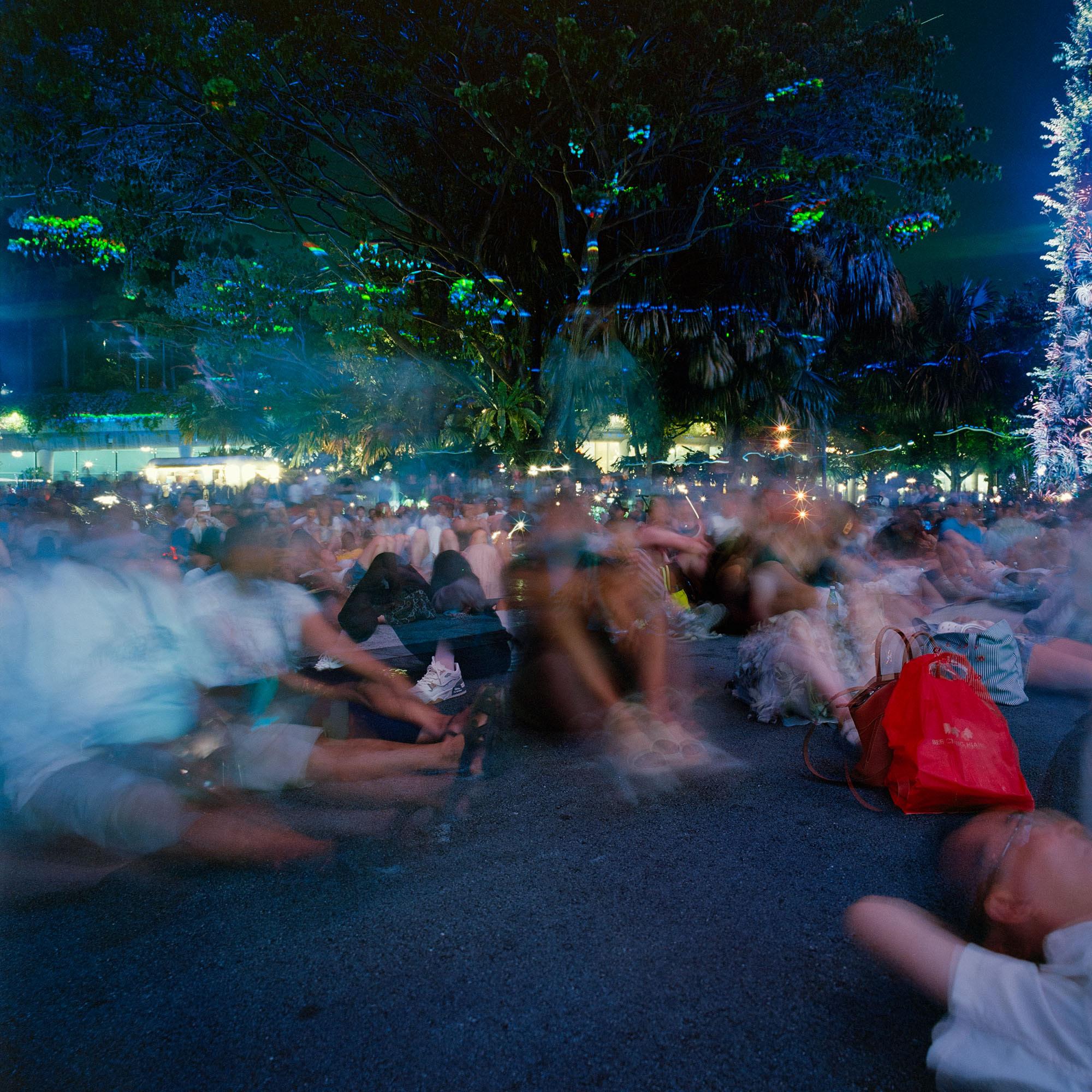
Thomson Road, Singapore #1 (December 25, 2024)
2024
Fine art archival print
Edition of 3 + 2 Artist’s Proofs
H100 x W100 cm (image)



Silent Knight #07-12 2018 – 2021 Fine art archival print Edition of 3 + 2 Artist’s Proofs
H81.45 x W100 cm (image)
H100 x W122.7 cm (image)


Silent Knight (Singapore) 2018 – 2021 Fine art archival print Edition of 10 + 3 Artist’s Proofs H20.3 x W25.4 cm (each; set of 25)


Silent Knight #08-804 2018 – 2021 Fine art archival print Edition of 3 + 2 Artist’s Proofs
H81.45 x W100 cm (image)
H100 x W122.7 cm (image)
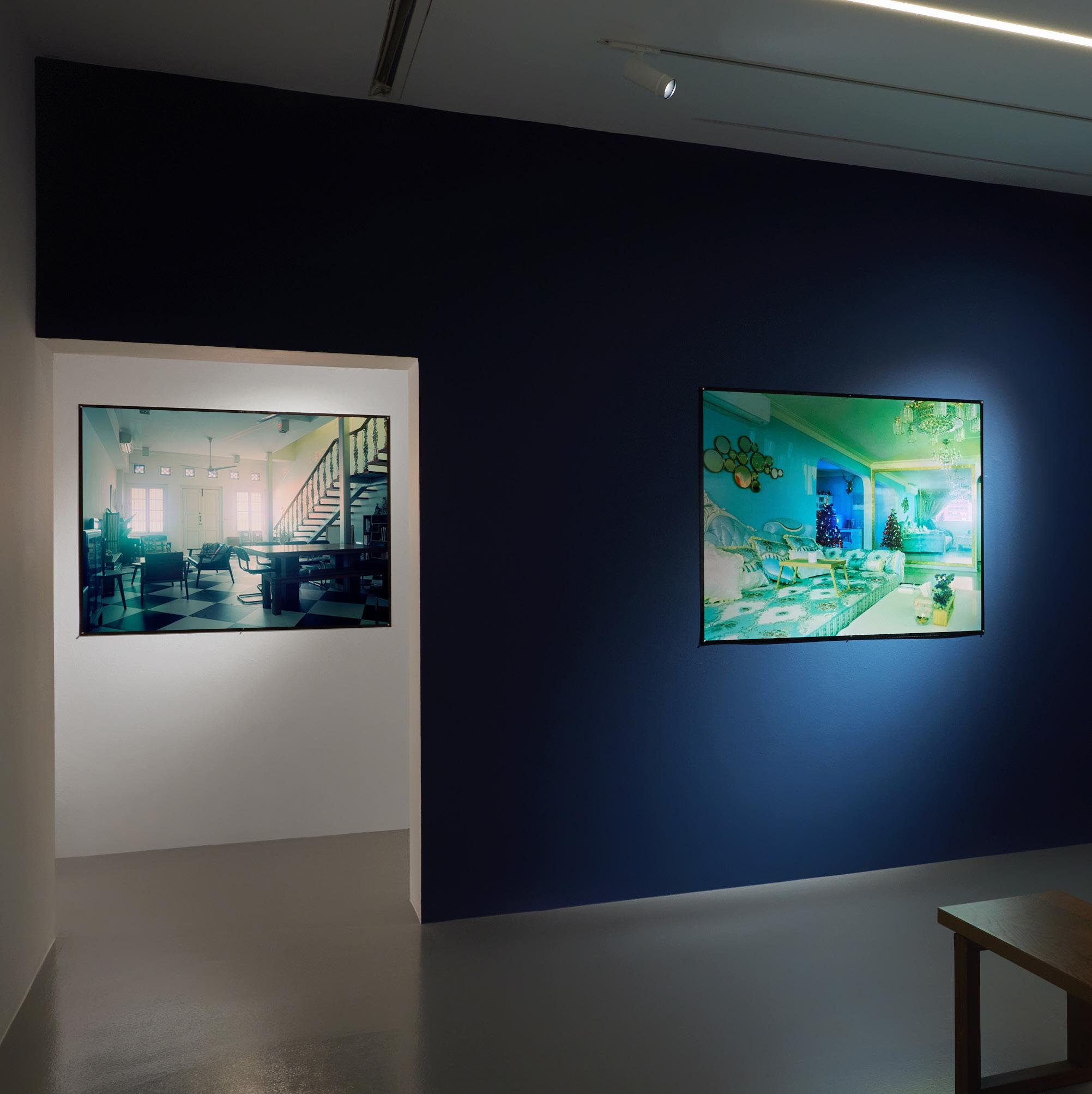
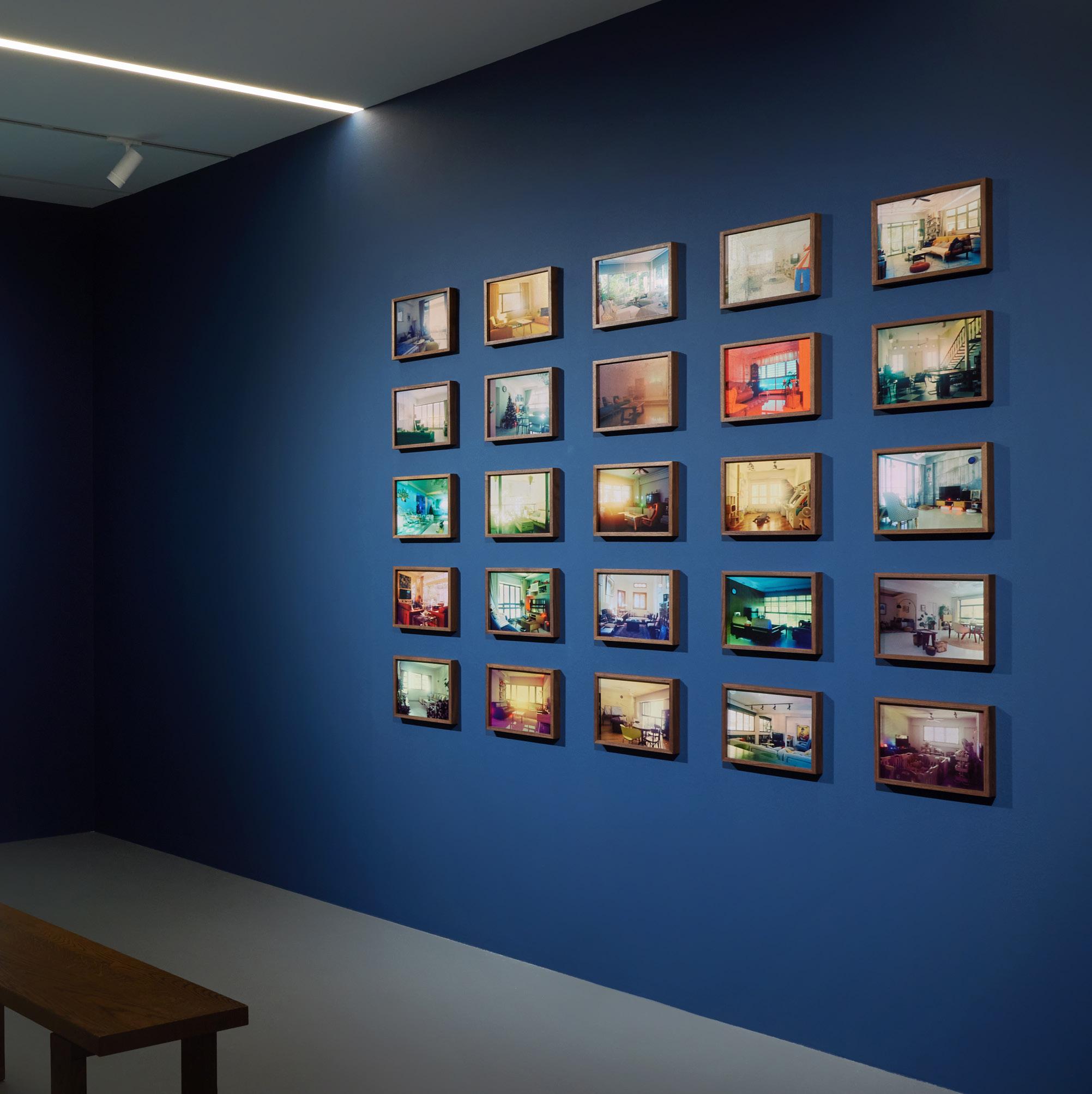
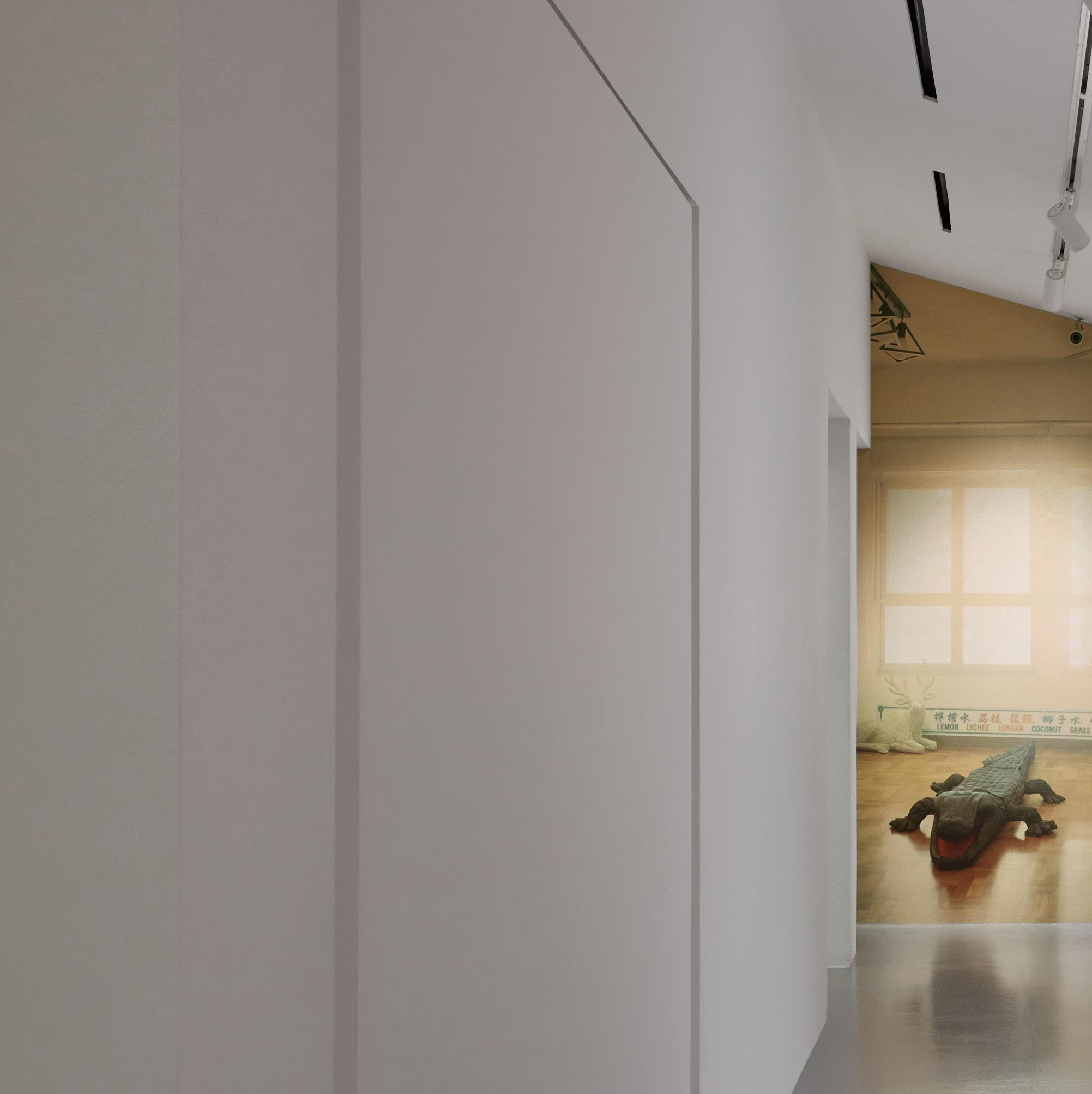

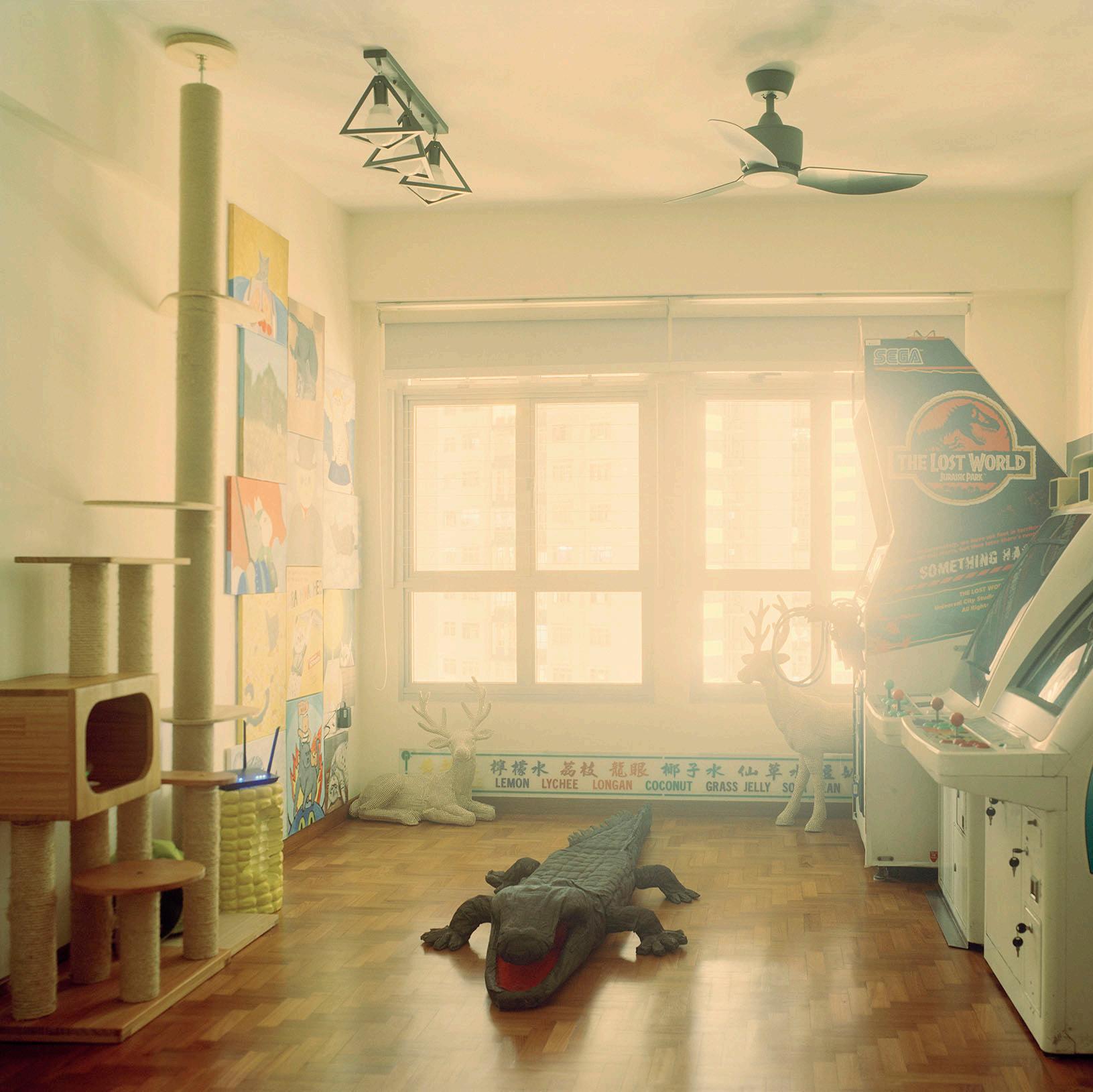

Silent Knight #13-70 2018 – 2021 Fine art archival print Edition of 3 + 2 Artist’s Proofs
H81.45 x W100 cm (image)
H100 x W122.7 cm (image)


Silent Knight #161 2018 – 2021 Fine art archival print Edition of 3 + 2 Artist’s Proofs
H81.45 x W100 cm (image)
H100 x W122.7 cm (image)


Silent Knight #150 2018 – 2021 Fine art archival print Edition of 3 + 2 Artist’s Proofs
H81.45 x W100 cm (image)
H100 x W122.7 cm (image)
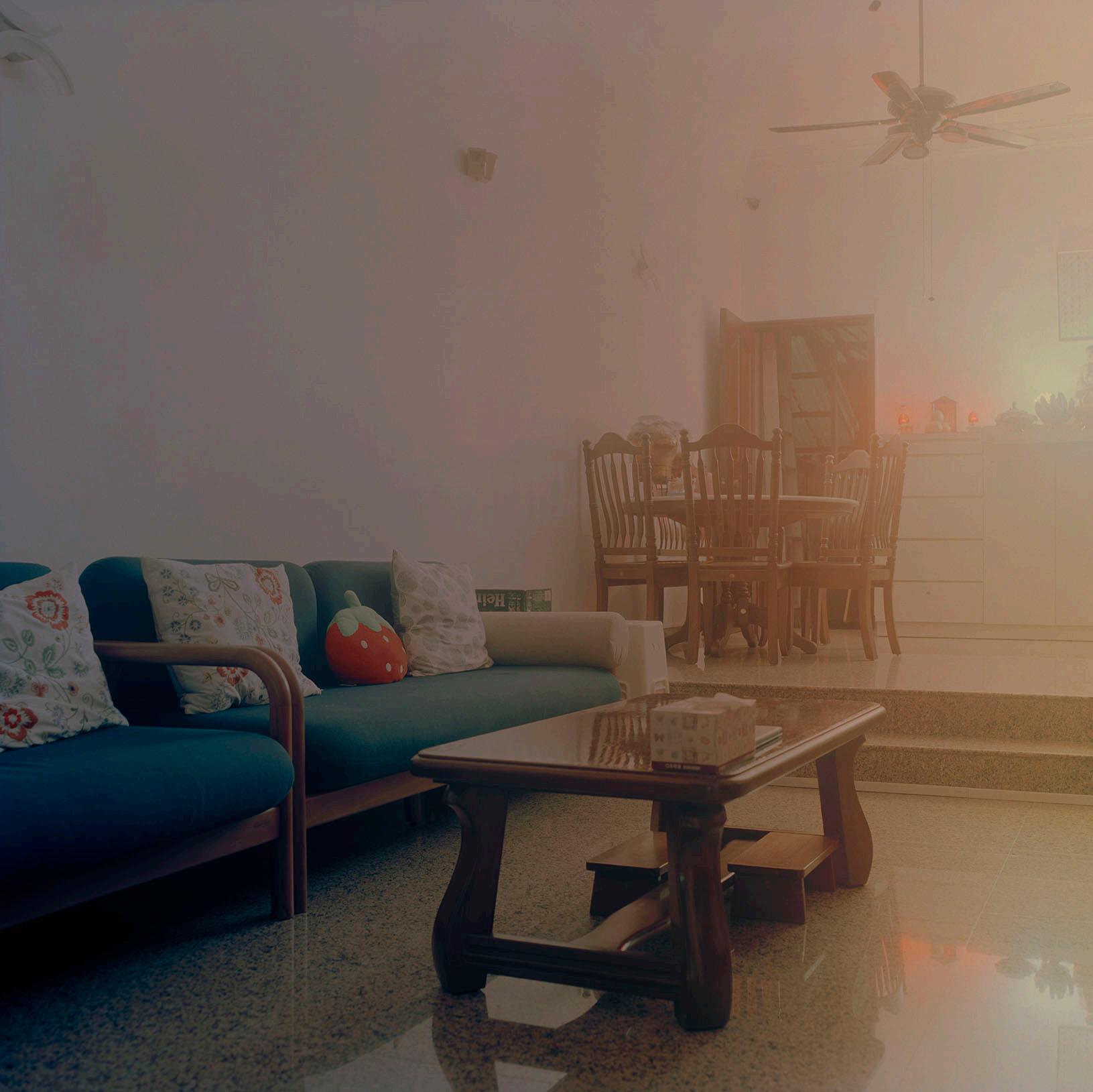

Silent Knight #20F 2018 – 2021 Fine art archival print Edition of 3 + 2 Artist’s Proofs
H81.45 x W100 cm (image)
H100 x W122.7 cm (image)
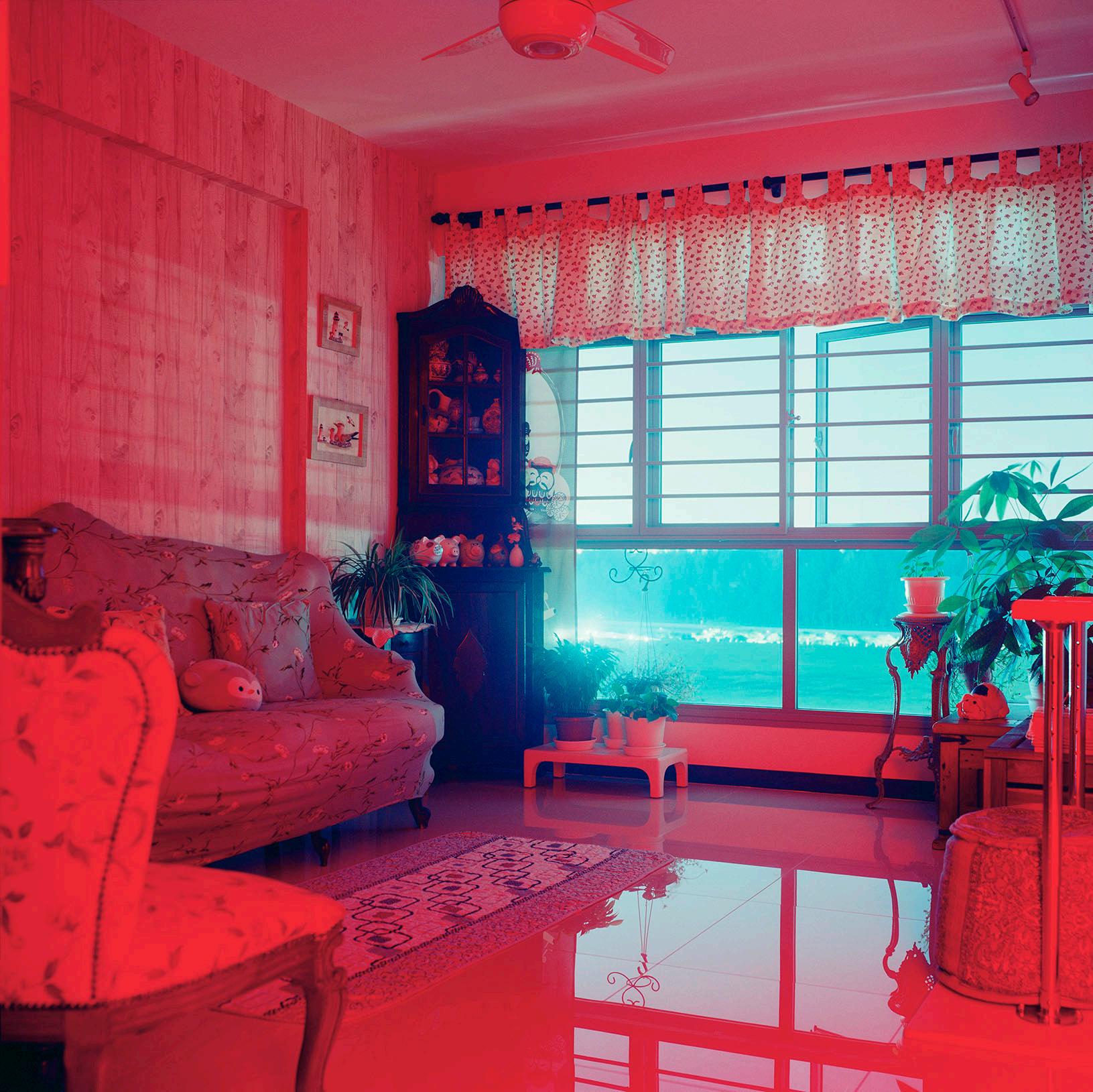

Silent Knight #10-745 2018 – 2021 Fine art archival print Edition of 3 + 2 Artist’s Proofs
H81.45 x W100 cm (image)
H100 x W122.7 cm (image)

E-mail Telephone Website
15 November – 30 December 2025
FOST Gallery, Singapore
Photographer Lavender Chang
FOST Gallery
1 Lock Road
#01-02, Gillman Barracks Singapore 108932 65 6694 3080 info@fostgallery.com www.fostgallery.com
© FOST Private Limited
© All artwork images copyright Sebastian Mary Tay
© All installation views copyright FOST Gallery ISBN 978-981-18-0521-9
This catalogue is copyright. Apart from any fair dealing for the purposes of private study, research, criticism or review as permitted under the Copyright Act, no part may be reproduced by any process without written permission.
Cover: Yuan Ching Road, Singapore #1 (October 11, 2025) | 2025 | Fine art archival print | Edition of 3 + 2 Artist’s Proofs | H100 x W100 cm (image)
Back Cover: Silent Knight #13-70 | 2018 – 2021 | Fine art archival print | Edition of 3 + 2 Artist’s Proofs | H81.45 x W100 cm (image) | H100 x W122.7 cm (image)

